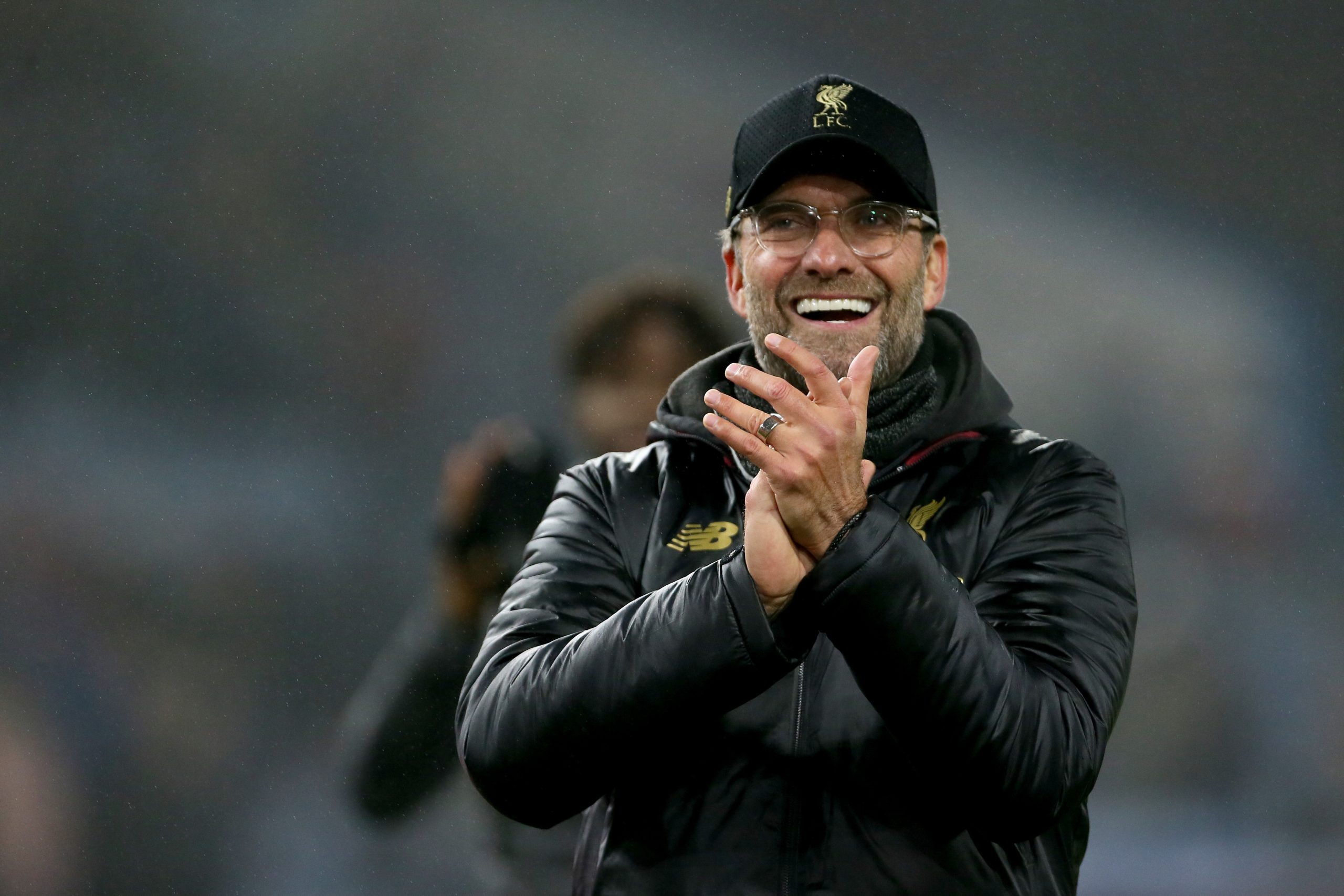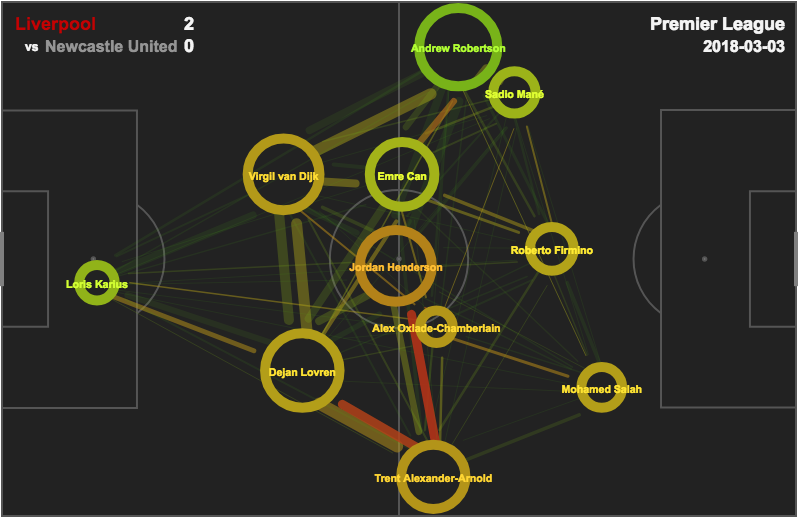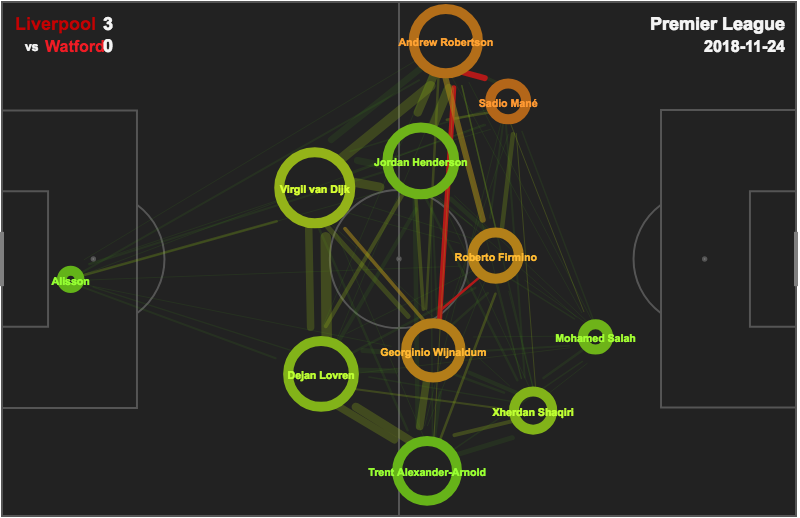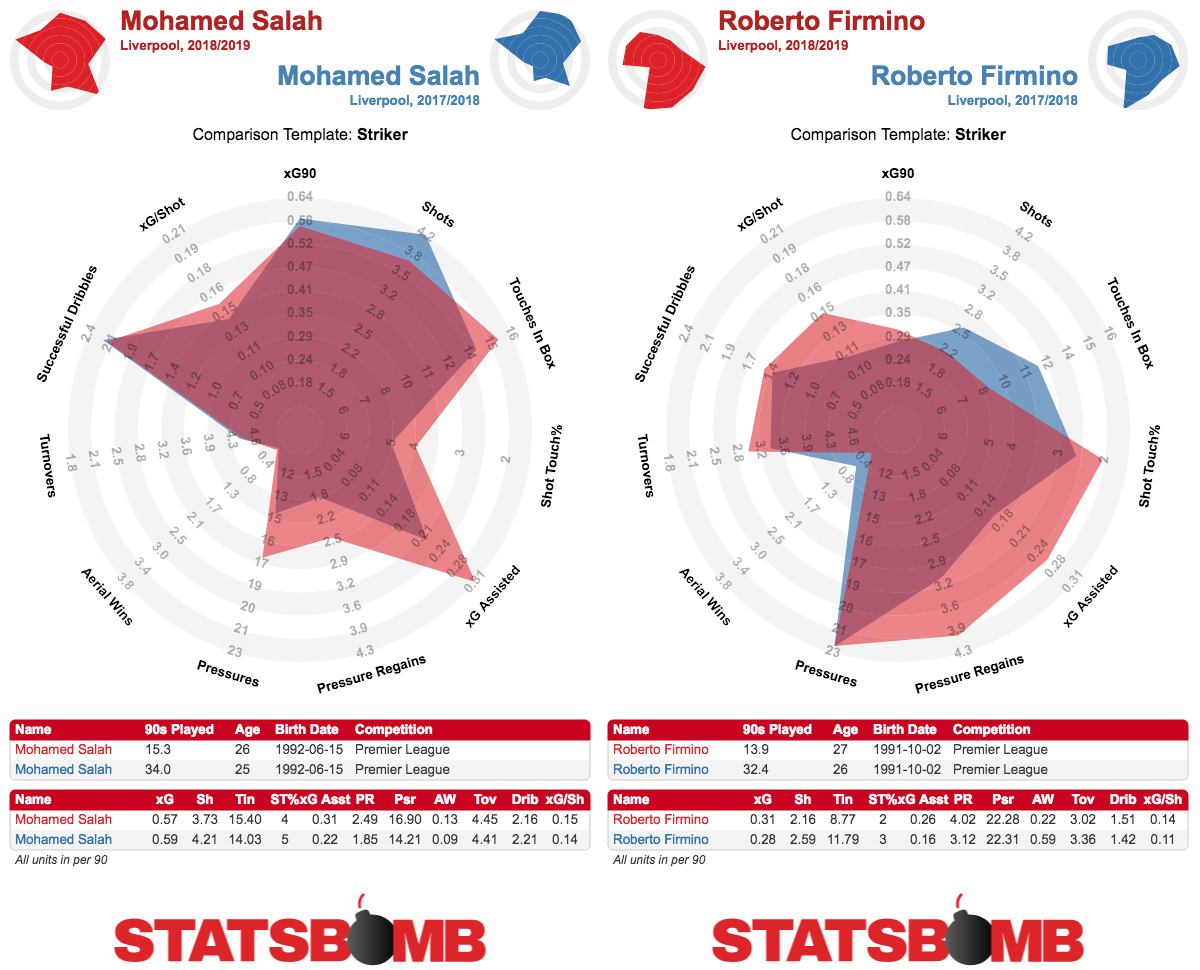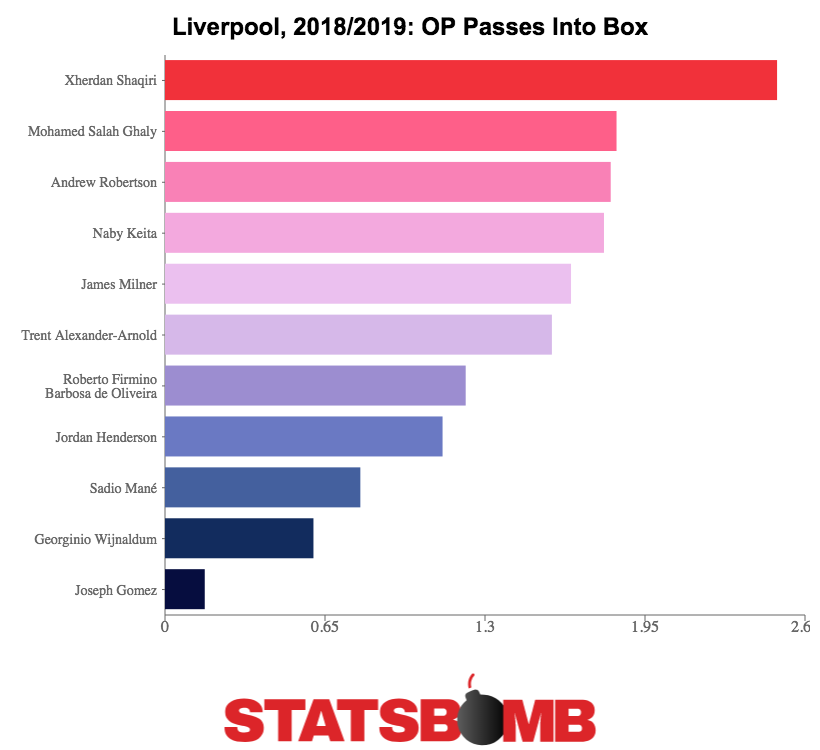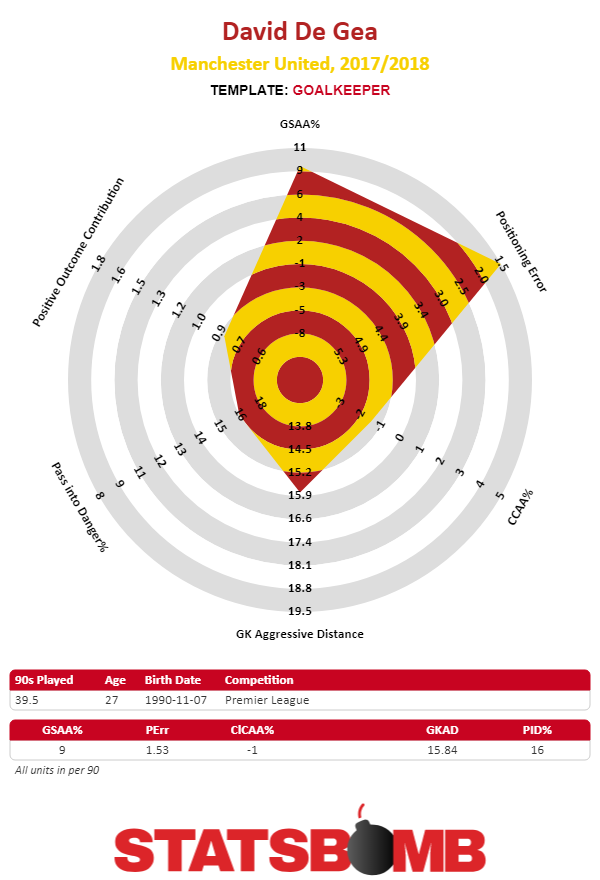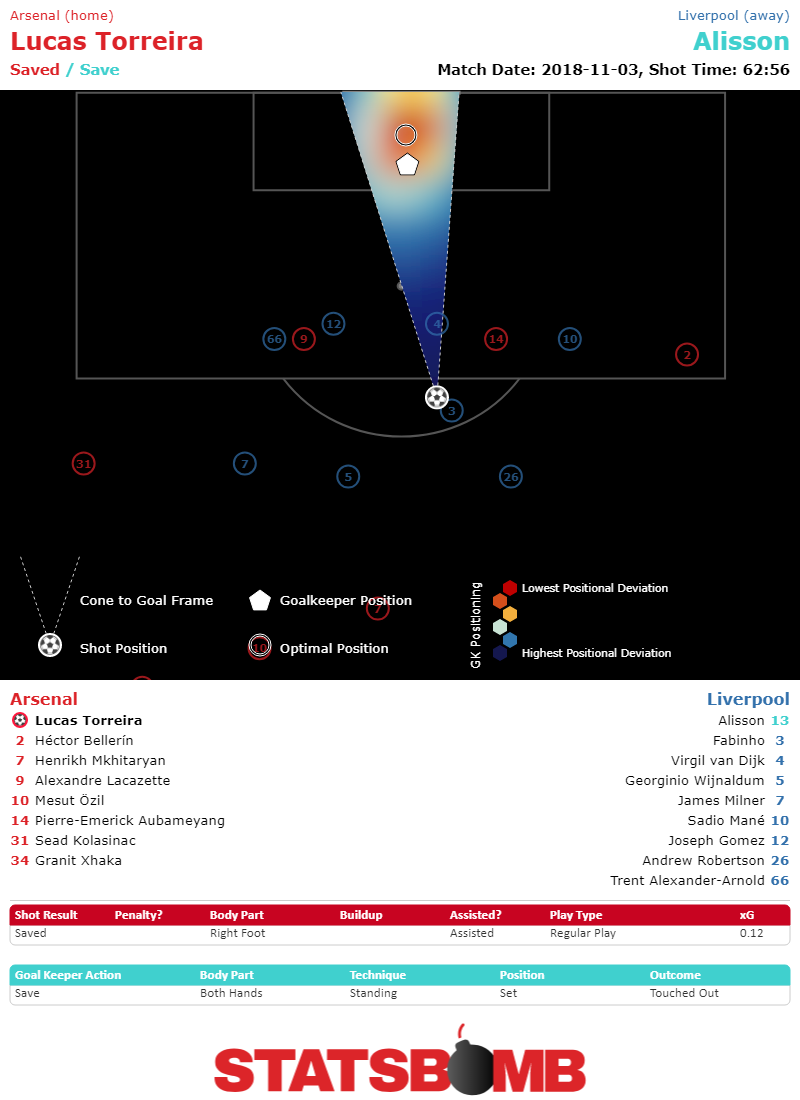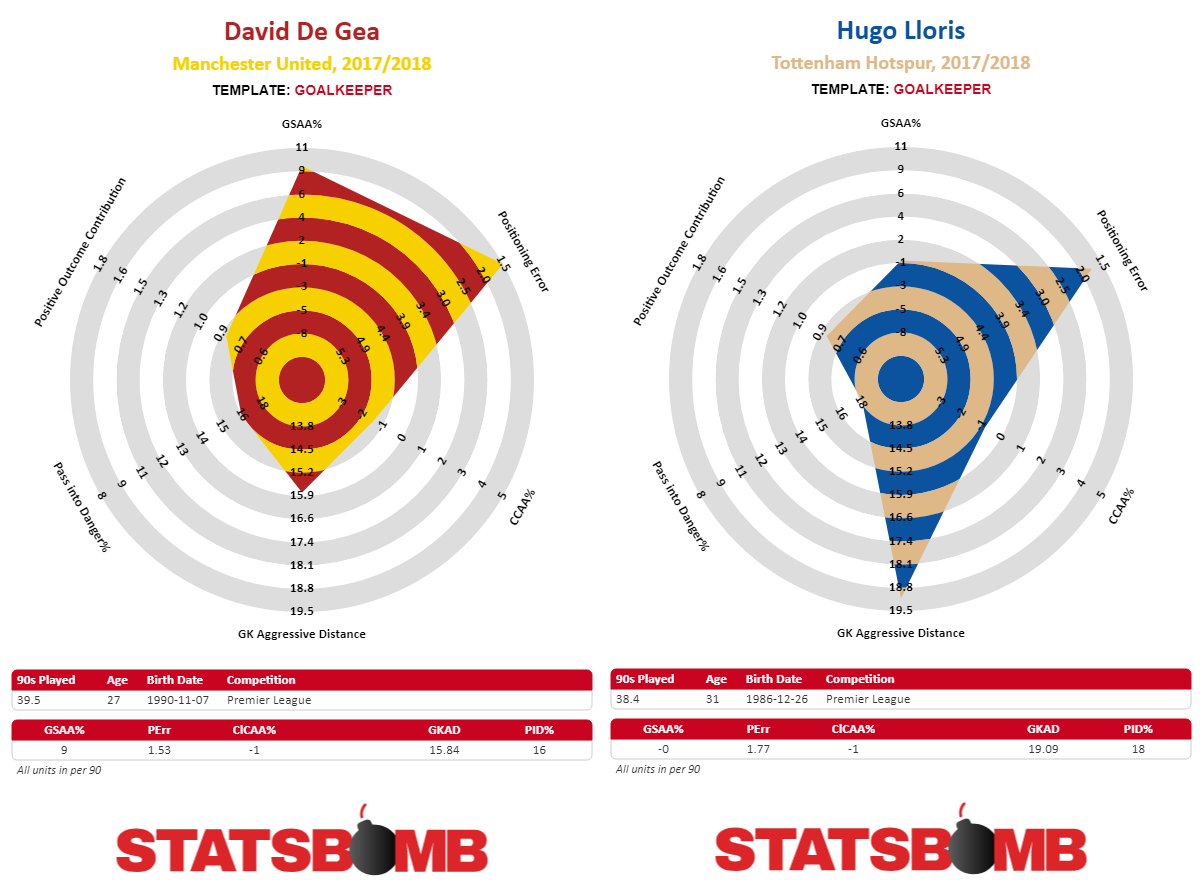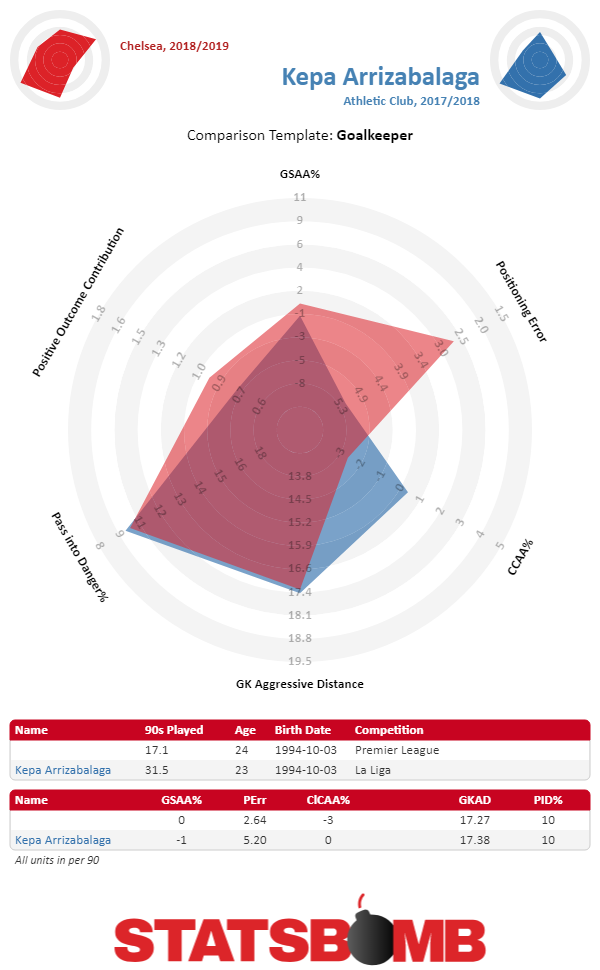This Saturday Rangers host Celtic in the second Old Firm derby of the season. Steven Gerrard's side are within touching distance of the champions. A Rangers win would put the teams level on forty-two points at the top of the Scottish Premiership, igniting a title race as we enter 2019. However, Brendan Rodgers' team does have a game in hand and a superior goal difference so a victory for Celtic would set up a significant lead. The early kick off this weekend is a key match in deciding this season's title. (Note - data is for Celtic after 18 games and Rangers after 19 games). 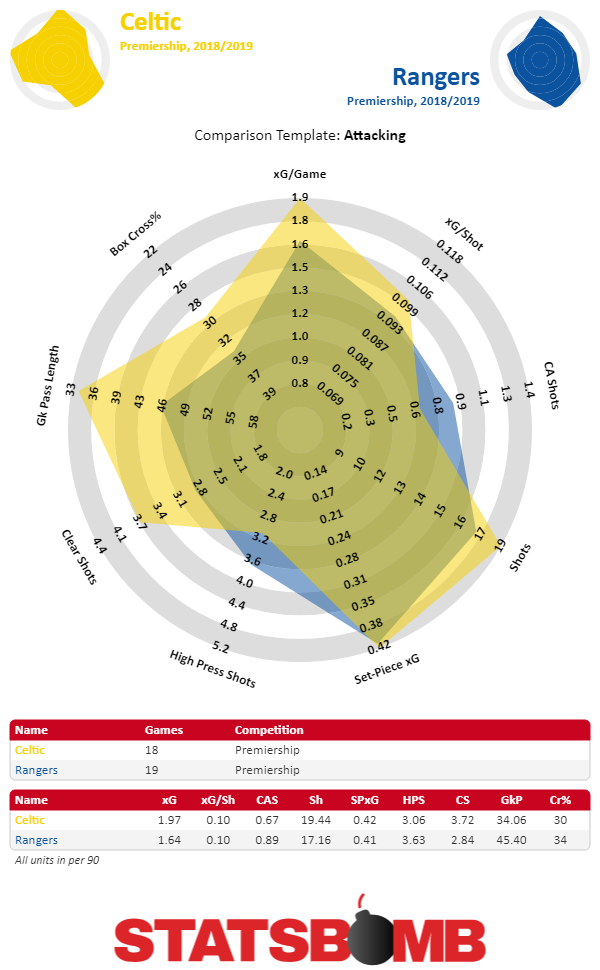
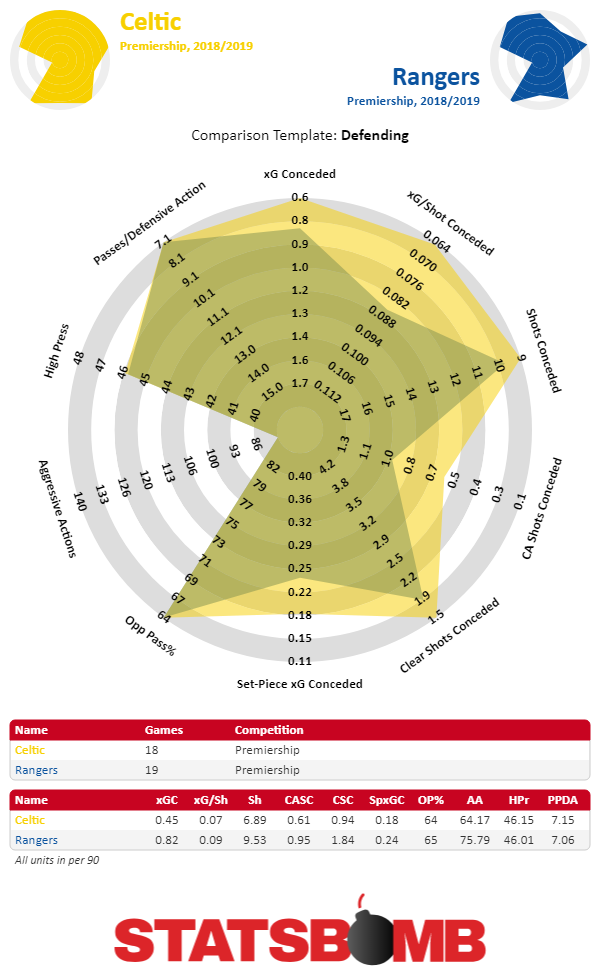
Clear Progress For Rangers Despite Right Wing Reliance
Rangers have managed to bring themselves within three points of Celtic but December has in some ways felt like a tough month for them. A disappointing loss in Vienna led to elimination from the Europa League. The domestic schedule got busy and they picked up some injuries. They managed to score more than one goal in only two of their seven SPFL Premiership matches. Those matches included draws with Hibernian at home and also away to bottom team Dundee. Narrow victories over Hamilton and St Johnstone weren't really of the expected standard either. Steven Gerrard has been quick to point this out himself. Perhaps mindful of the currently developing, childish spat between Hearts manager Craig Levein and Aberdeen manager Derek McInnes he was keen to stress that he didn't mean any disrespect to St Johnstone when suggesting that Perth was a place Rangers should not struggle to win in. The truth though is that these were all games Rangers perhaps should have won comfortably. The encouraging thing is that their underlying numbers do show positive indications about how they are performing. 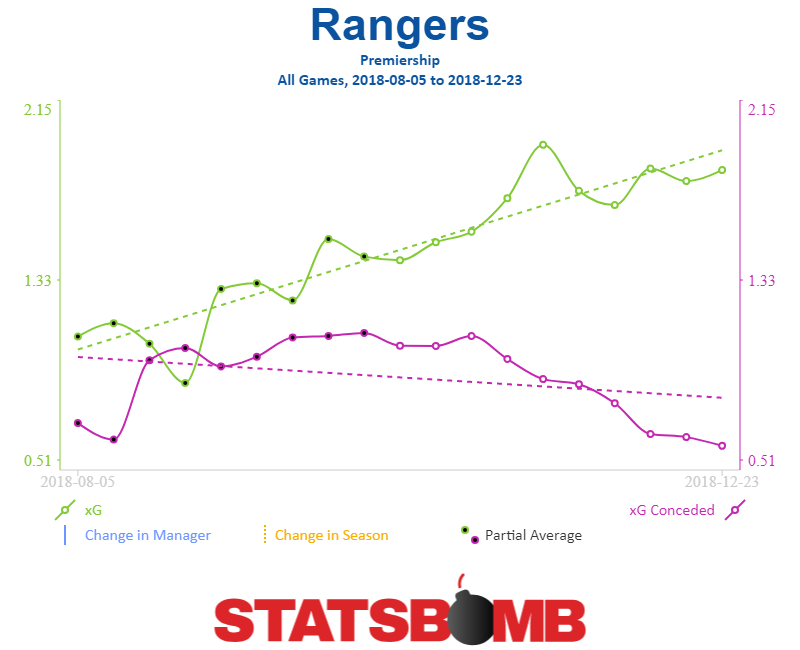 Rangers have an average expected goals per match of 1.64 and an average xG Conceded per match of 0.83. That puts them solidly in second place in the table in terms of xG difference and progress is clearly being made on both sides of the ball. They generate these numbers by taking a whopping seventeen shots every game and conceding just under ten attempts at their own goal. Alfredo Morelos, the twenty-two year old Colombian centre forward, takes around a quarter of those shots and is top scorer in the league with twelve goals. He has had a fantastic season so far and is key for the team in terms of hold up play, rolling opposition centre backs and combining with teammates on the right flank.
Rangers have an average expected goals per match of 1.64 and an average xG Conceded per match of 0.83. That puts them solidly in second place in the table in terms of xG difference and progress is clearly being made on both sides of the ball. They generate these numbers by taking a whopping seventeen shots every game and conceding just under ten attempts at their own goal. Alfredo Morelos, the twenty-two year old Colombian centre forward, takes around a quarter of those shots and is top scorer in the league with twelve goals. He has had a fantastic season so far and is key for the team in terms of hold up play, rolling opposition centre backs and combining with teammates on the right flank. 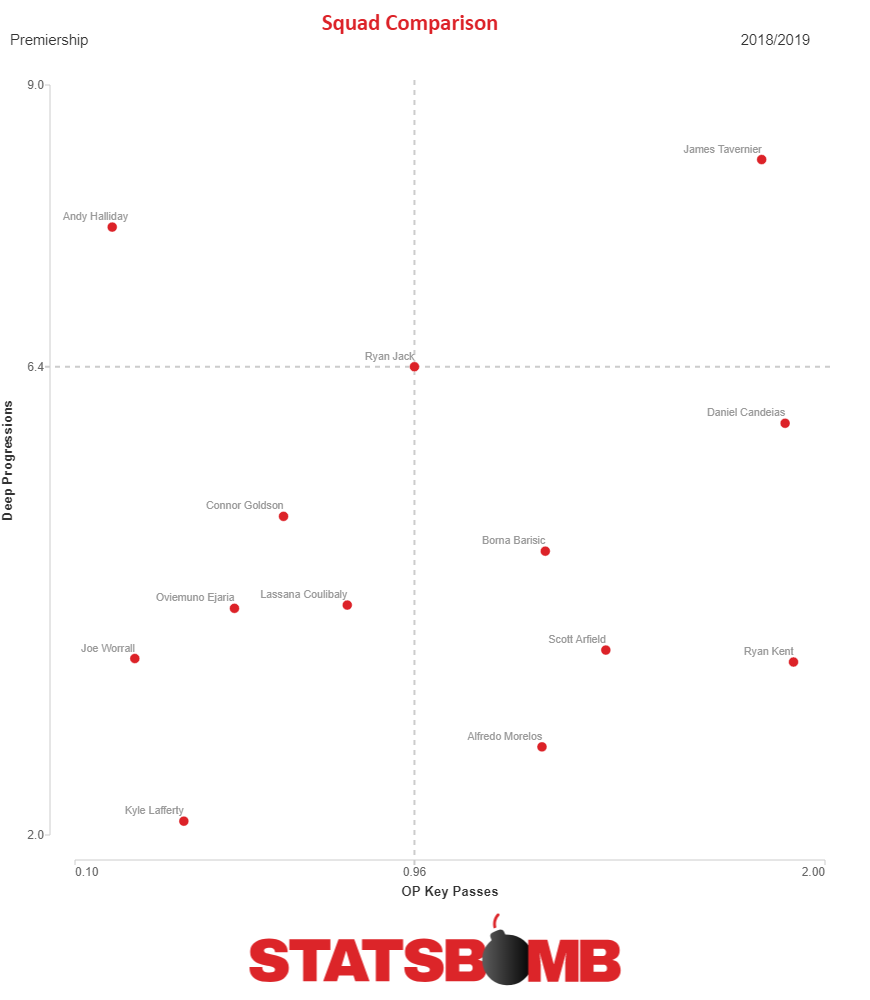 That right flank is very important for Rangers. The dominance of right back James Tavernier and right winger Daniel Candeias in terms of deep ball progression and key passes shows where most attacks originate from. Tavernier incredibly already has eight assists this season and both he and Candeias have great delivery from wide areas. However, this can lead to Rangers being a little predictable at times when in possession. The midfield lacks both a goal threat and a creative passer. Ovie Ejaria and Lassana Coulibaly have disappointed. Liverpool loanee Ejaria hasn't provided the ball progression that was expected and Coulibaly has made basic short passing errors too often. Coulibaly makes the most passes within the Rangers squad that lead to the recipient being under pressure despite being only the eighth highest in the squad for being passed to when he is under pressure. Scott Arfield has performed well and combines well with Morelos but seems likely to miss this match due to injury. Longer term injuries to Jamie Murphy and Ryan Kent have also robbed Rangers of a significant threat on the left wing. This has been compounded by injuries to first choice left back Borna Barisic. Usual replacement Jon Flanagan does not provide much of an attacking threat and has also looked uncomfortable defensively at times too.
That right flank is very important for Rangers. The dominance of right back James Tavernier and right winger Daniel Candeias in terms of deep ball progression and key passes shows where most attacks originate from. Tavernier incredibly already has eight assists this season and both he and Candeias have great delivery from wide areas. However, this can lead to Rangers being a little predictable at times when in possession. The midfield lacks both a goal threat and a creative passer. Ovie Ejaria and Lassana Coulibaly have disappointed. Liverpool loanee Ejaria hasn't provided the ball progression that was expected and Coulibaly has made basic short passing errors too often. Coulibaly makes the most passes within the Rangers squad that lead to the recipient being under pressure despite being only the eighth highest in the squad for being passed to when he is under pressure. Scott Arfield has performed well and combines well with Morelos but seems likely to miss this match due to injury. Longer term injuries to Jamie Murphy and Ryan Kent have also robbed Rangers of a significant threat on the left wing. This has been compounded by injuries to first choice left back Borna Barisic. Usual replacement Jon Flanagan does not provide much of an attacking threat and has also looked uncomfortable defensively at times too. 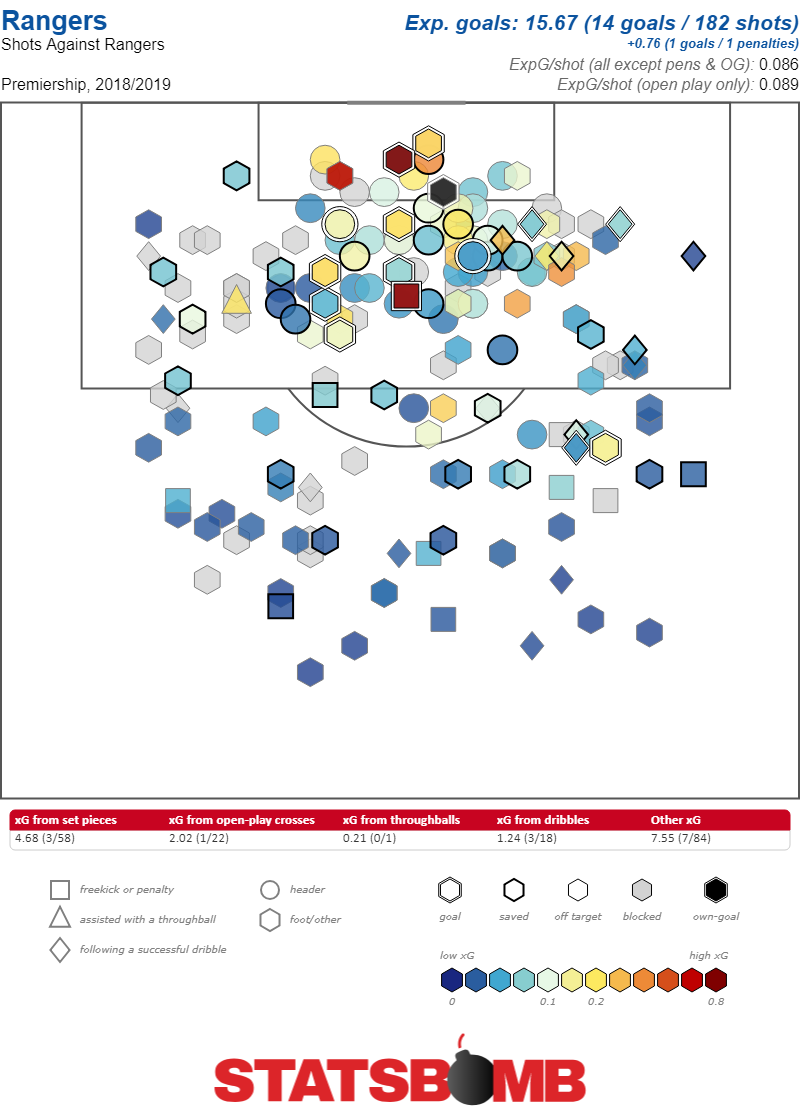 The areas behind both full backs, particularly when Tavernier has joined the attack, can lead to opposition chances against Rangers. Their defensive numbers are improving but at times they have had to be bailed out by some incredible shot stopping by goalkeeper Allan McGregor. There have also been some inconsistencies in terms of the central defensive partnership. While Gerrard seems to be firmly wedded to a 4-3-3 formation he has chopped and changed personnel throughout the season. Some of this has been enforced due to injuries and a punishing fixture schedule but in defence he has seemed unsure of his ideal pairing. Although Connor Goldson made an error for St Johnstone's goal a week ago it has to be hoped he has recovered from the knock sustained on Boxing Day against Hibernian as he and Joe Worrall have been an effective partnership recently.
The areas behind both full backs, particularly when Tavernier has joined the attack, can lead to opposition chances against Rangers. Their defensive numbers are improving but at times they have had to be bailed out by some incredible shot stopping by goalkeeper Allan McGregor. There have also been some inconsistencies in terms of the central defensive partnership. While Gerrard seems to be firmly wedded to a 4-3-3 formation he has chopped and changed personnel throughout the season. Some of this has been enforced due to injuries and a punishing fixture schedule but in defence he has seemed unsure of his ideal pairing. Although Connor Goldson made an error for St Johnstone's goal a week ago it has to be hoped he has recovered from the knock sustained on Boxing Day against Hibernian as he and Joe Worrall have been an effective partnership recently.
Title Winning Numbers But Questions Over Ball Progression For Celtic.
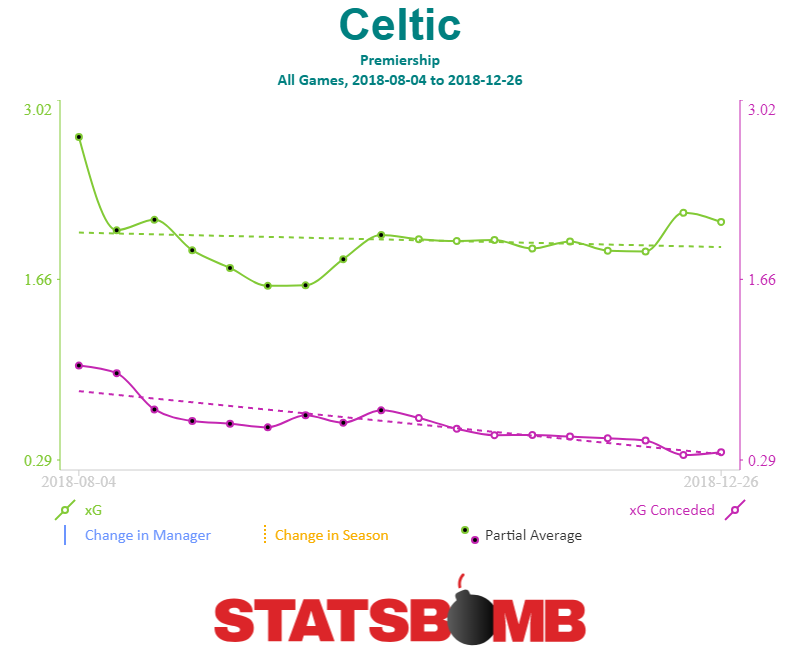 Celtic are managing to take almost twenty shots every game this season. They are limiting their opponents to less than seven attempts at their own goal. The Hoops are averaging 1.97 xG per match and conceding just 0.45 xG on average. Although they did have a blip in mid December, losing to Red Bull Salzburg and Hibernian, they have been very impressive recently. Rodgers' team has only conceded one goal at home since October 20th. They've scored three or more goals in four of their six league matches in December. Although Rangers are just three points behind Celtic still look favourites to win the league.
Celtic are managing to take almost twenty shots every game this season. They are limiting their opponents to less than seven attempts at their own goal. The Hoops are averaging 1.97 xG per match and conceding just 0.45 xG on average. Although they did have a blip in mid December, losing to Red Bull Salzburg and Hibernian, they have been very impressive recently. Rodgers' team has only conceded one goal at home since October 20th. They've scored three or more goals in four of their six league matches in December. Although Rangers are just three points behind Celtic still look favourites to win the league. 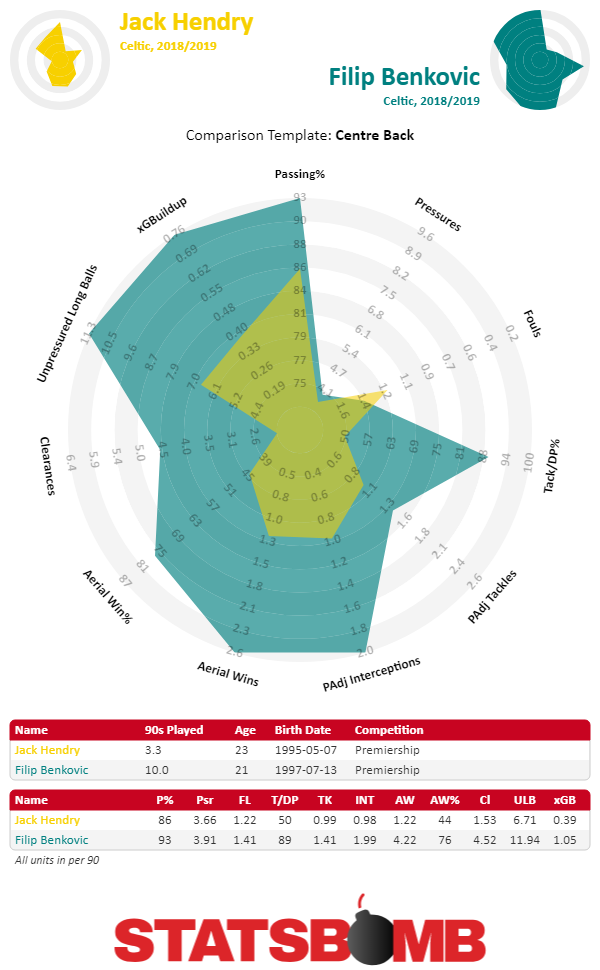 Filip Benkovic has been a key part of Celtic's strong defensive performance. He and Dedryck Boyata have formed a formidable partnership since the Leicester loanee replaced the then injured Kristoffer Ajer and the underperforming Jack Hendry. A concern for Celtic is that left back Kieran Tierney may miss this match through injury. The young star is a significant loss both in terms of the ball winning and ball progression he provides for the side. Tierney's usual replacement, Emilio Izaguirre, was substituted at half time in Celtic's most recent match after giving up a penalty following being repeatedly exposed by passes in behind him. Given the importance of the right flank to Rangers either Izaguirre or his own replacement Jonny Hayes is in for a testing match. Right back Mikael Lustig is a capable defender and goalkeeper Craig Gordon is a fine shot stopper but both do limit Celtic in an attacking sense. Gordon's distribution can be poor and Lustig, now aged thirty-two, doesn't get into advanced areas enough to help Celtic overload opponents.
Filip Benkovic has been a key part of Celtic's strong defensive performance. He and Dedryck Boyata have formed a formidable partnership since the Leicester loanee replaced the then injured Kristoffer Ajer and the underperforming Jack Hendry. A concern for Celtic is that left back Kieran Tierney may miss this match through injury. The young star is a significant loss both in terms of the ball winning and ball progression he provides for the side. Tierney's usual replacement, Emilio Izaguirre, was substituted at half time in Celtic's most recent match after giving up a penalty following being repeatedly exposed by passes in behind him. Given the importance of the right flank to Rangers either Izaguirre or his own replacement Jonny Hayes is in for a testing match. Right back Mikael Lustig is a capable defender and goalkeeper Craig Gordon is a fine shot stopper but both do limit Celtic in an attacking sense. Gordon's distribution can be poor and Lustig, now aged thirty-two, doesn't get into advanced areas enough to help Celtic overload opponents. 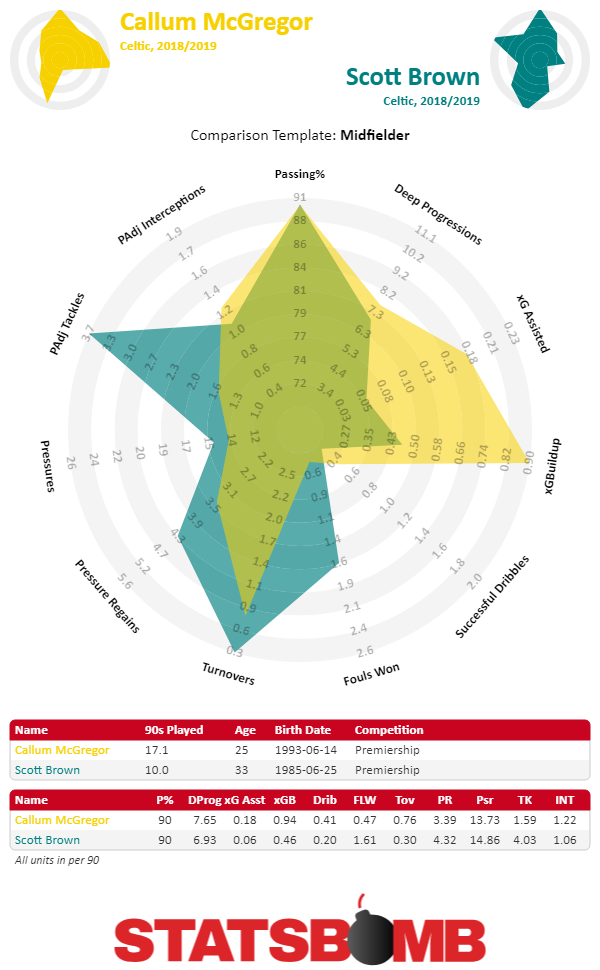 For some of the second quarter of this season Celtic played Callum McGregor in the 6 position instead of Scott Brown. This helped quicken ball progression, removed some of the onus on their centre backs to break the lines and gave more of a creative passing threat from the centre of the pitch. Brown is back in the team now and is a great source of aggression, tackling and experience. In the most recent match against Aberdeen his return did lead to centre backs Benkovic and Boyata being the main, and largely ineffectual, outlet for ball progression as the opposition sat deep from the start of the second half. It will be interesting to see if this continues against Rangers.
For some of the second quarter of this season Celtic played Callum McGregor in the 6 position instead of Scott Brown. This helped quicken ball progression, removed some of the onus on their centre backs to break the lines and gave more of a creative passing threat from the centre of the pitch. Brown is back in the team now and is a great source of aggression, tackling and experience. In the most recent match against Aberdeen his return did lead to centre backs Benkovic and Boyata being the main, and largely ineffectual, outlet for ball progression as the opposition sat deep from the start of the second half. It will be interesting to see if this continues against Rangers. 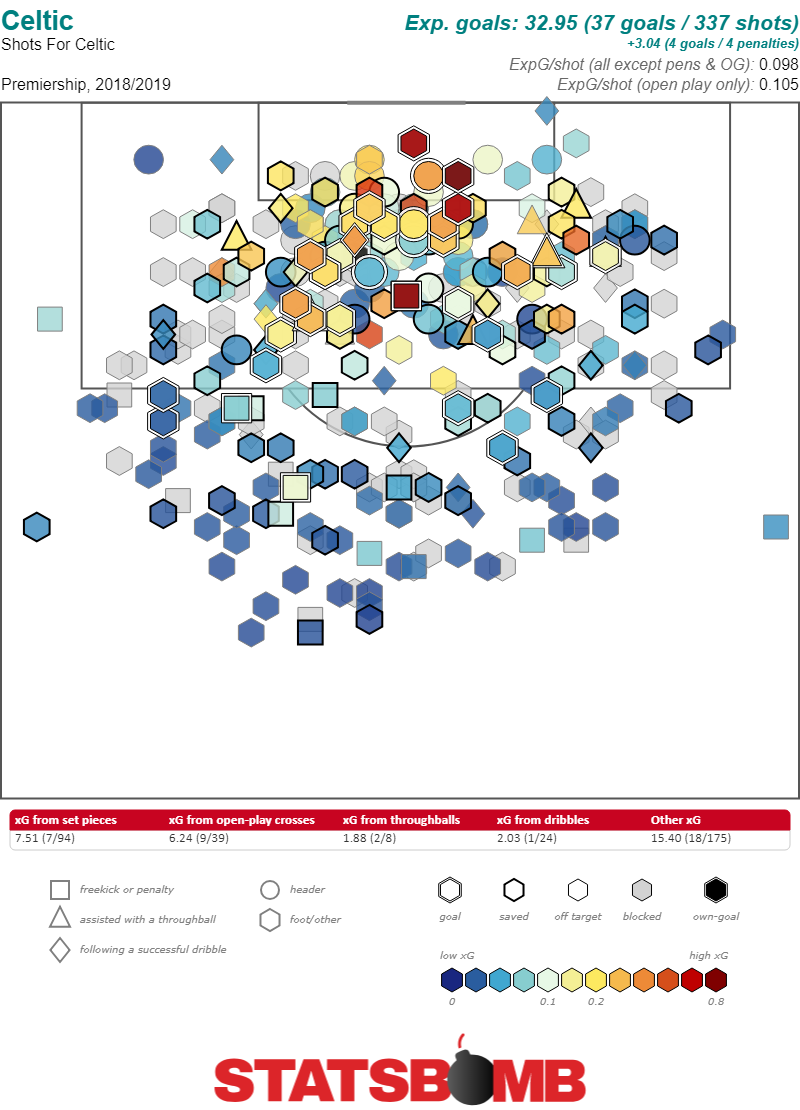 Other options in midfield include Ryan Christie and Olivier Ntcham. Ntcham can be wasteful with long shots - he's not responsible for all of those outside the box efforts shown above but it is close! However, he makes almost double the number of deep progressions compared to every other Celtic player. His ability to bring the ball into dangerous areas might mean Rodgers will recall him to the starting lineup and he did score the only goal the last time Celtic met Rangers. In the absence of a threat from full back and with Tom Rogic unavailable due to international duty Celtic will need James Forrest and Scott Sinclair to focus on getting behind the opposition in wide areas. Forrest's goal flurry earlier in the season and Sinclair's hat-trick in the last match were impressive but much will depend on the service they get to centre forward Odsonne Edouard. The twenty year old Frenchman showed against Aberdeen that he has the quality to decide matches but does need help to generate more shots.
Other options in midfield include Ryan Christie and Olivier Ntcham. Ntcham can be wasteful with long shots - he's not responsible for all of those outside the box efforts shown above but it is close! However, he makes almost double the number of deep progressions compared to every other Celtic player. His ability to bring the ball into dangerous areas might mean Rodgers will recall him to the starting lineup and he did score the only goal the last time Celtic met Rangers. In the absence of a threat from full back and with Tom Rogic unavailable due to international duty Celtic will need James Forrest and Scott Sinclair to focus on getting behind the opposition in wide areas. Forrest's goal flurry earlier in the season and Sinclair's hat-trick in the last match were impressive but much will depend on the service they get to centre forward Odsonne Edouard. The twenty year old Frenchman showed against Aberdeen that he has the quality to decide matches but does need help to generate more shots.
Must Win Match Could Be Decided By Centre Forwards
Although there are significant injuries for both Rangers and Celtic each will feel that this is a match they can and must win. Rangers might consider following the lead of Red Bull Salzburg and Hibernian by using a 4-4-2 diamond with the forwards splitting wide out of possession to pin back Celtic's full backs and a capable presser such as Daniel Candeias marking Celtic's deepest midfielder. Throughout this season the average distance from their own goal at which they are making aggressive actions has increased for Rangers. This gradually higher press is working judging by their underlying numbers but do they have the confidence to continue that against Celtic while not giving away too many fouls and picking up too many cards? Brendan Rodgers is undefeated against Rangers with ten wins out of twelve matches. Can this continue given possible personnel issues at left back? Can his attacking midfielders get in behind Rangers' fullbacks? 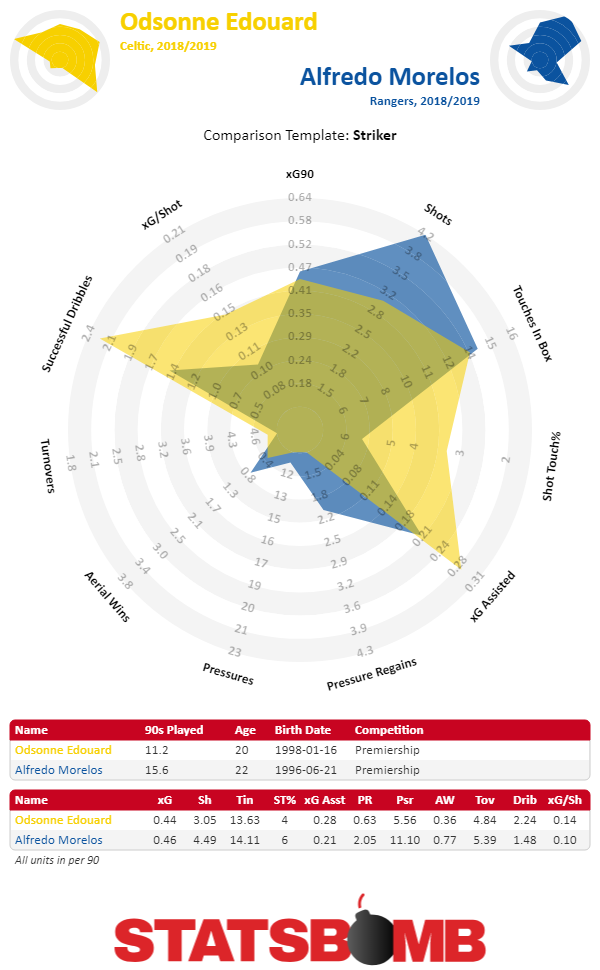 The two key figures on the day may be centre forwards Morelos and Edouard. Rangers need to set up better chances for Morelos and Celtic need to set up more chances for Edouard. If this happens then either youngster may have a decisive role in the Scottish title race.
The two key figures on the day may be centre forwards Morelos and Edouard. Rangers need to set up better chances for Morelos and Celtic need to set up more chances for Edouard. If this happens then either youngster may have a decisive role in the Scottish title race.
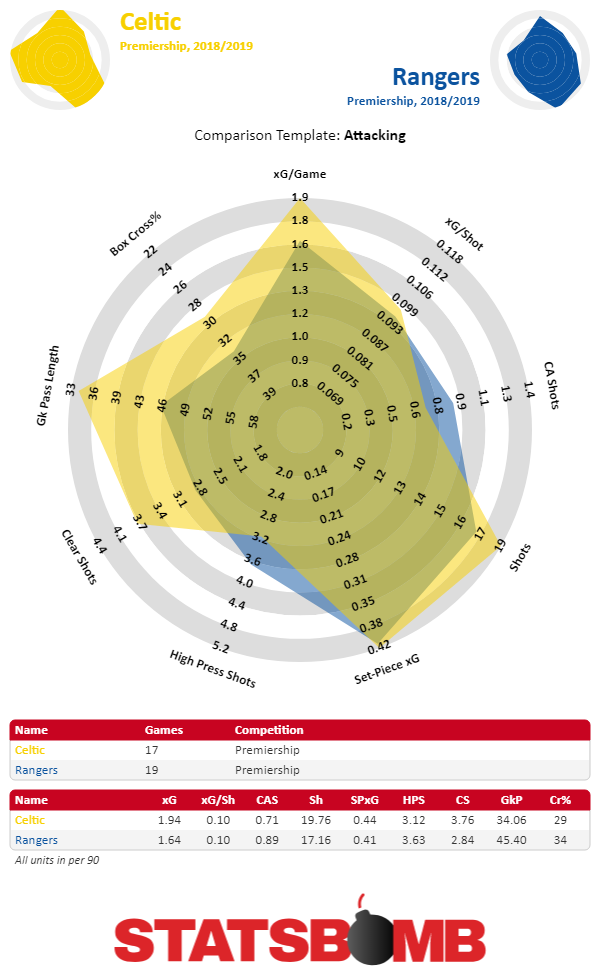
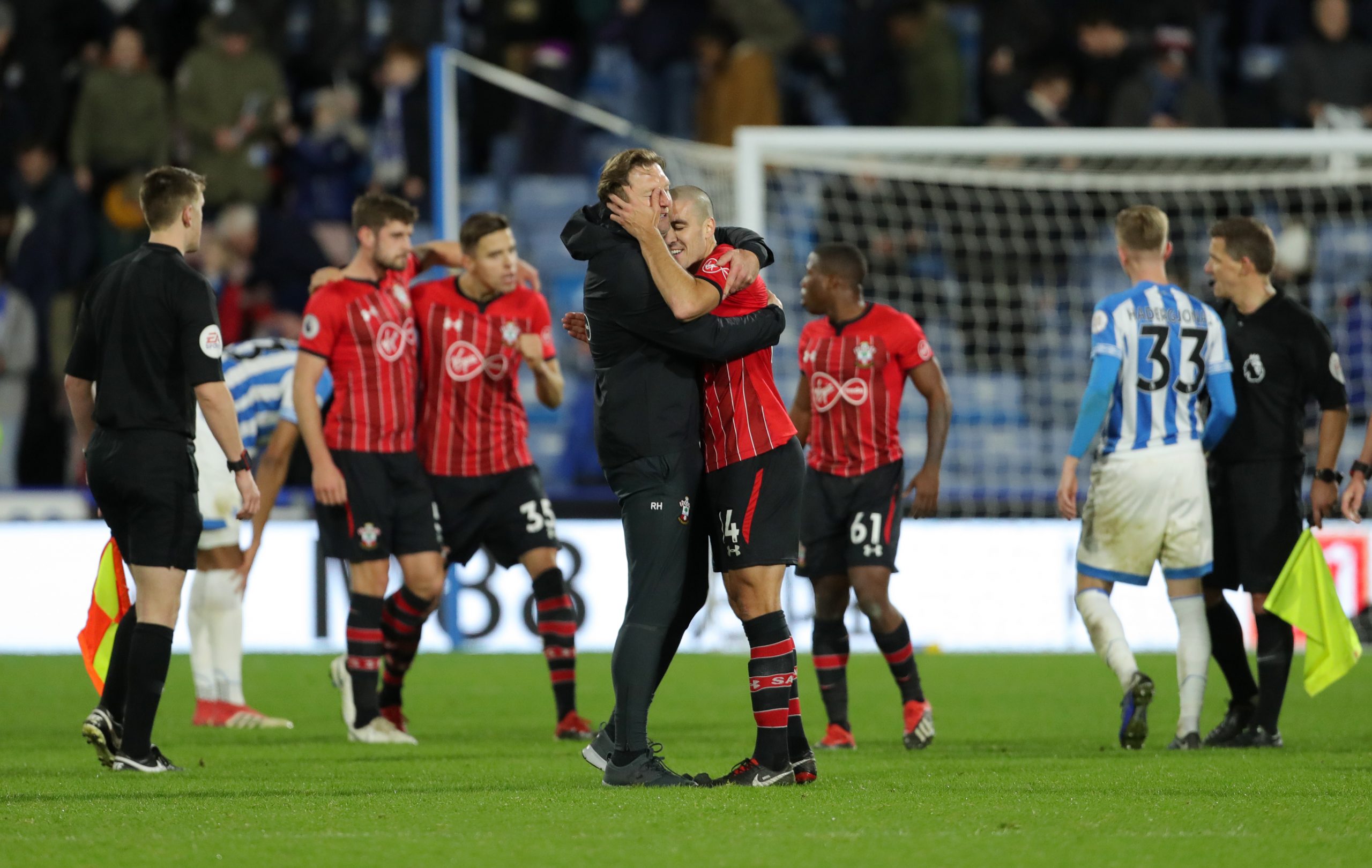
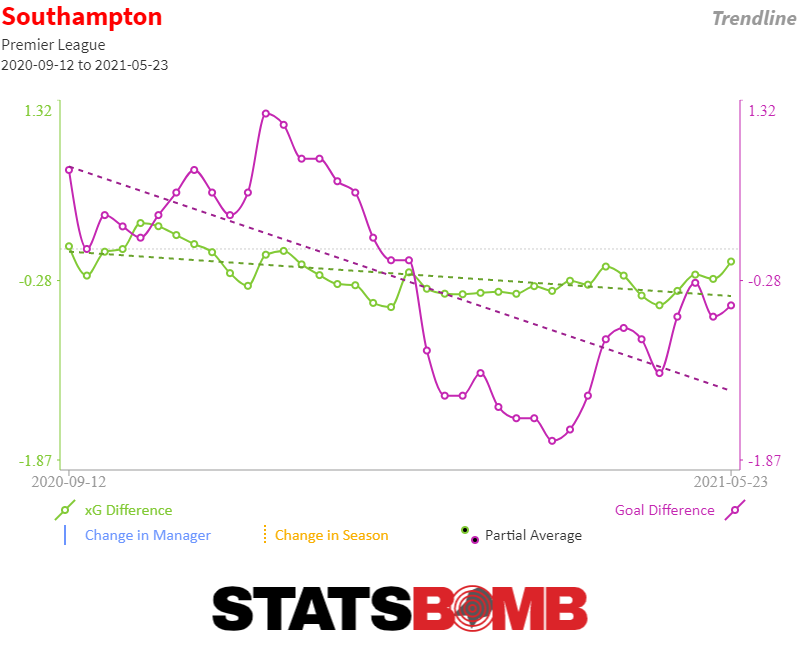
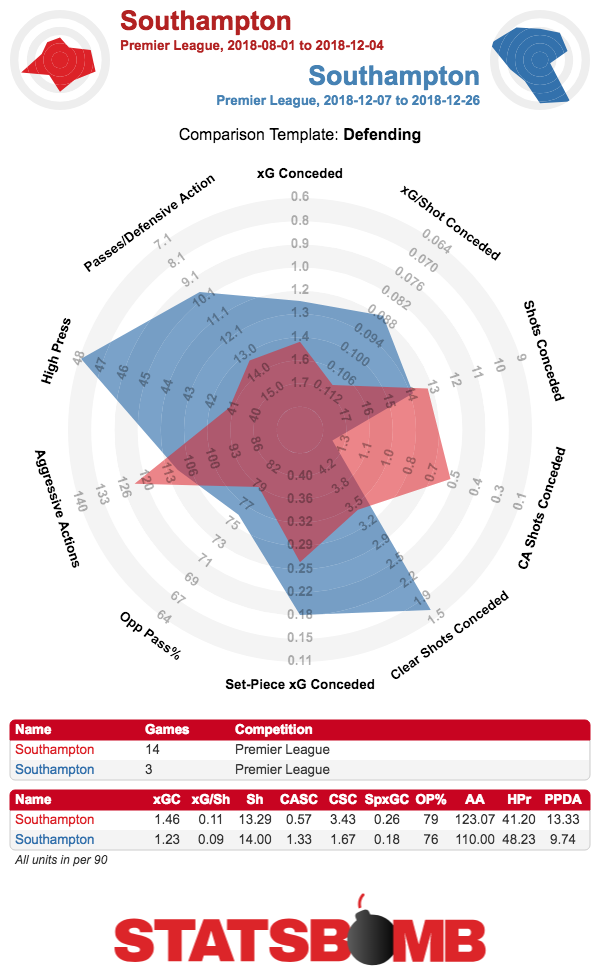
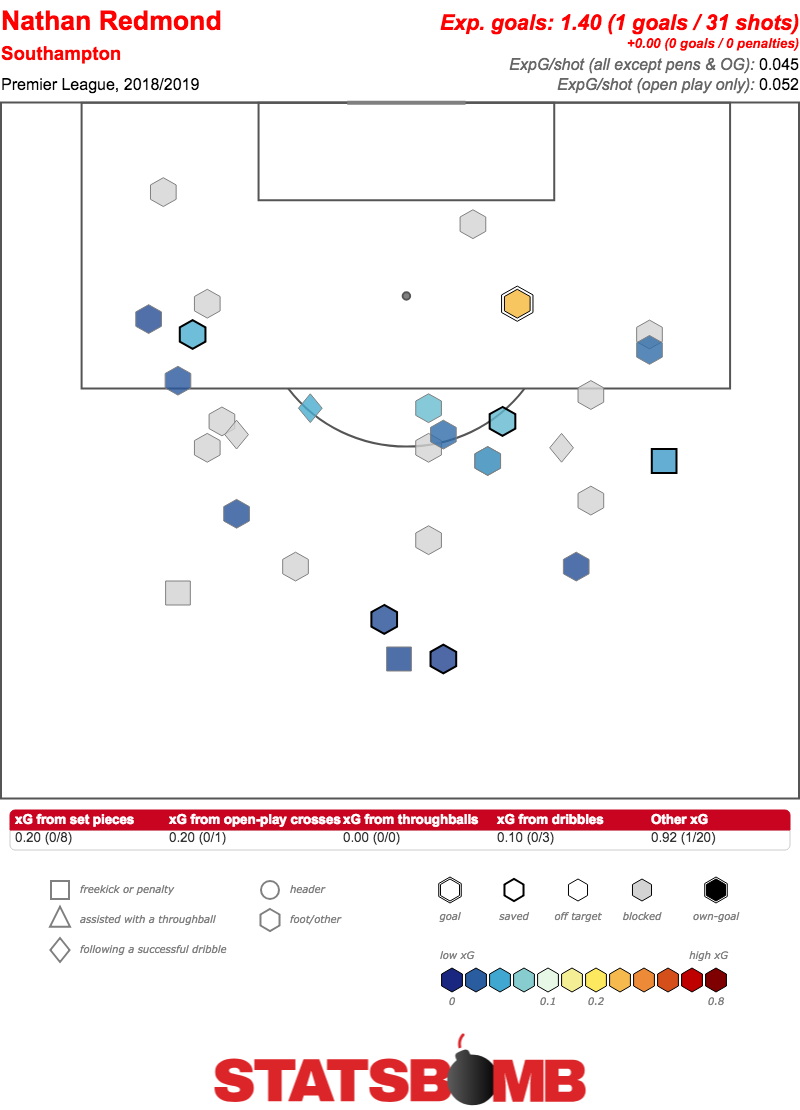
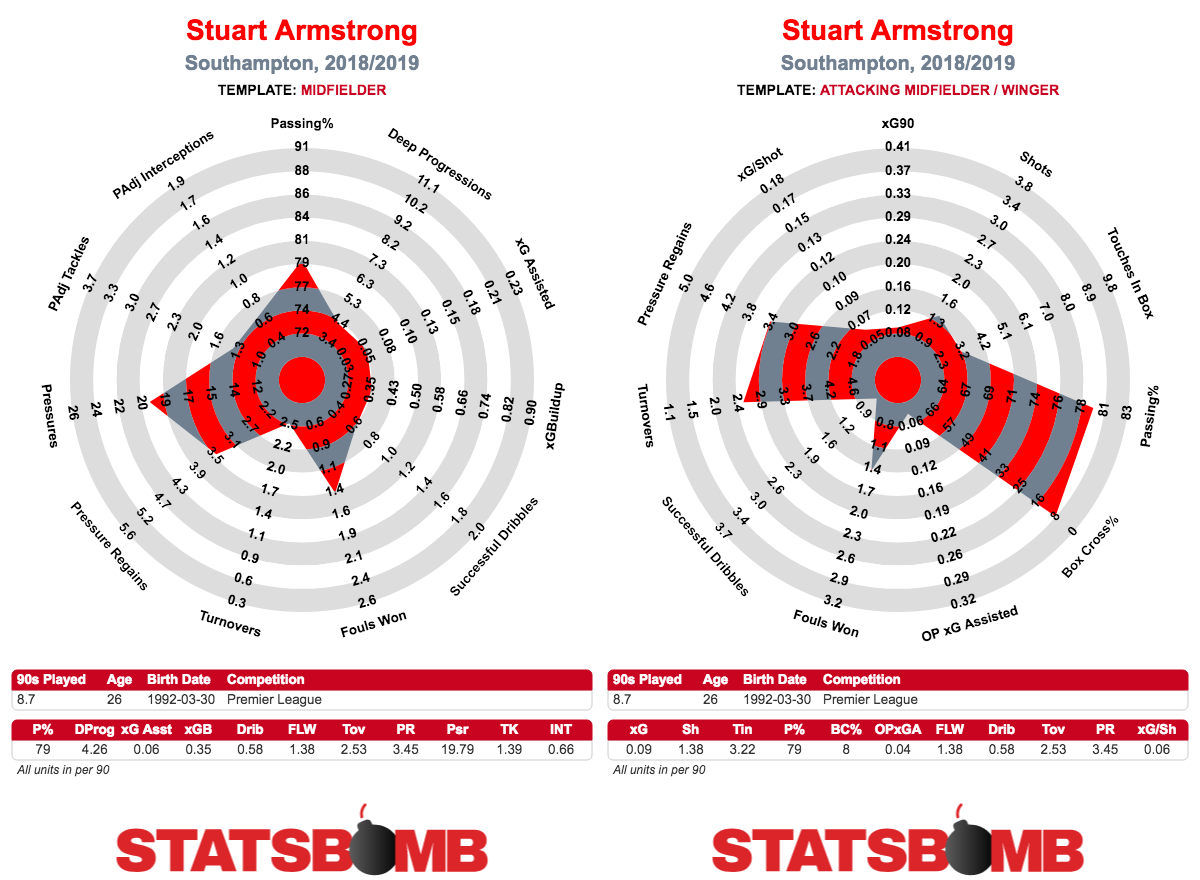
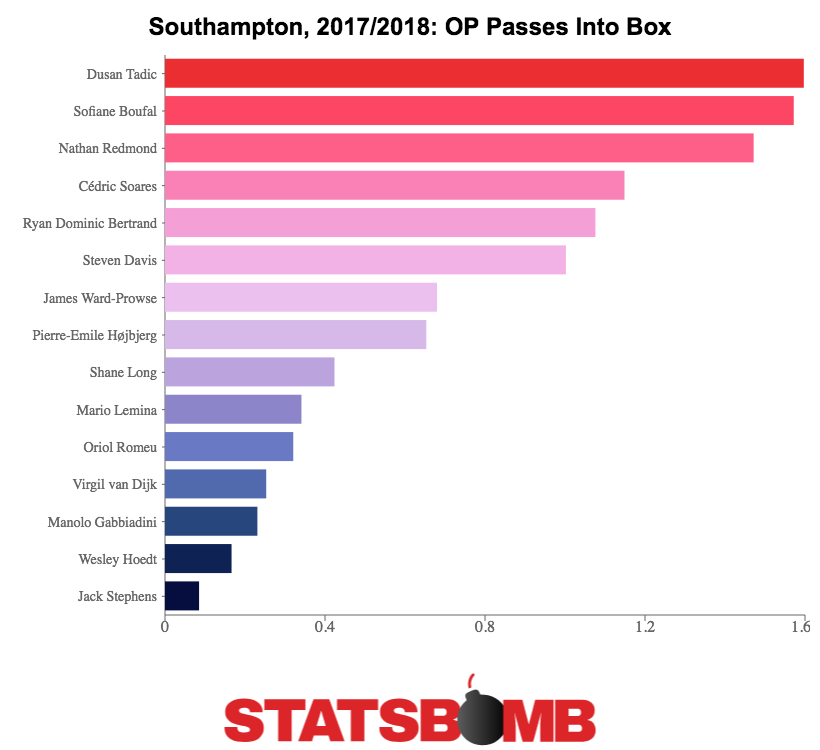
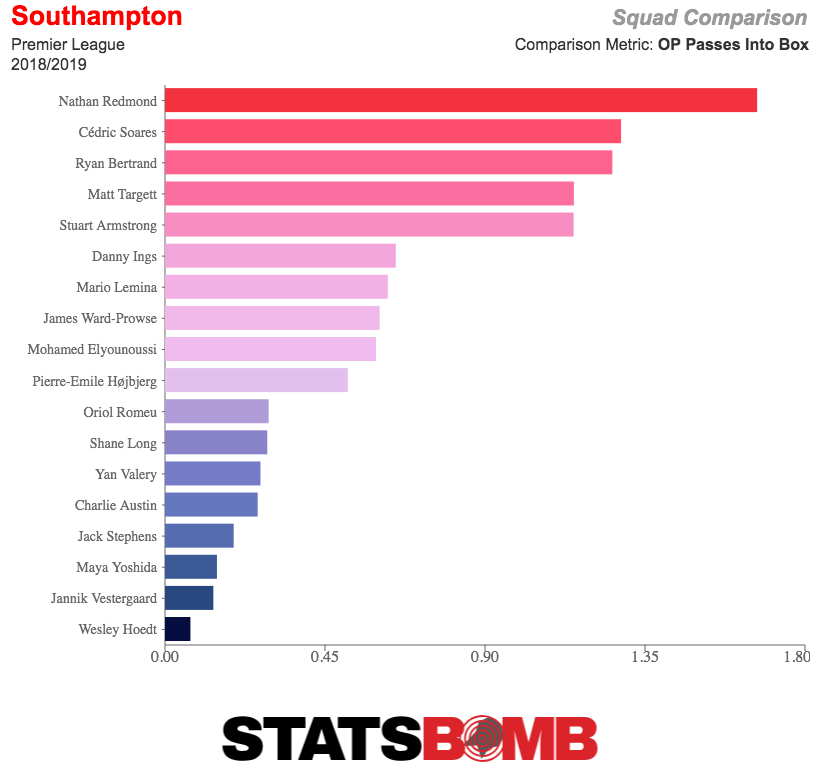
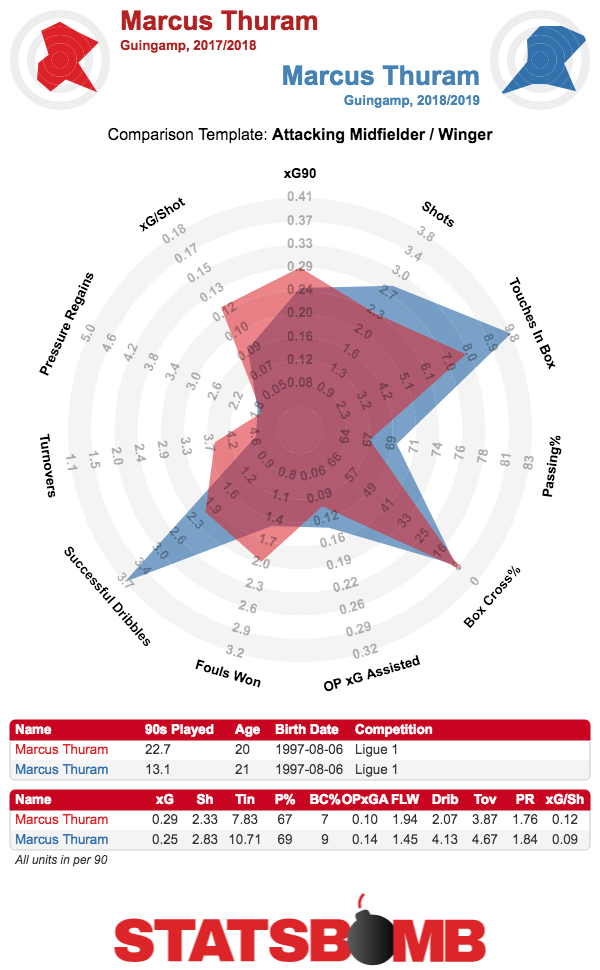
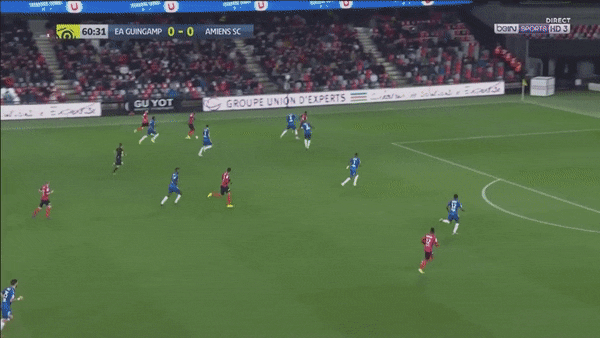
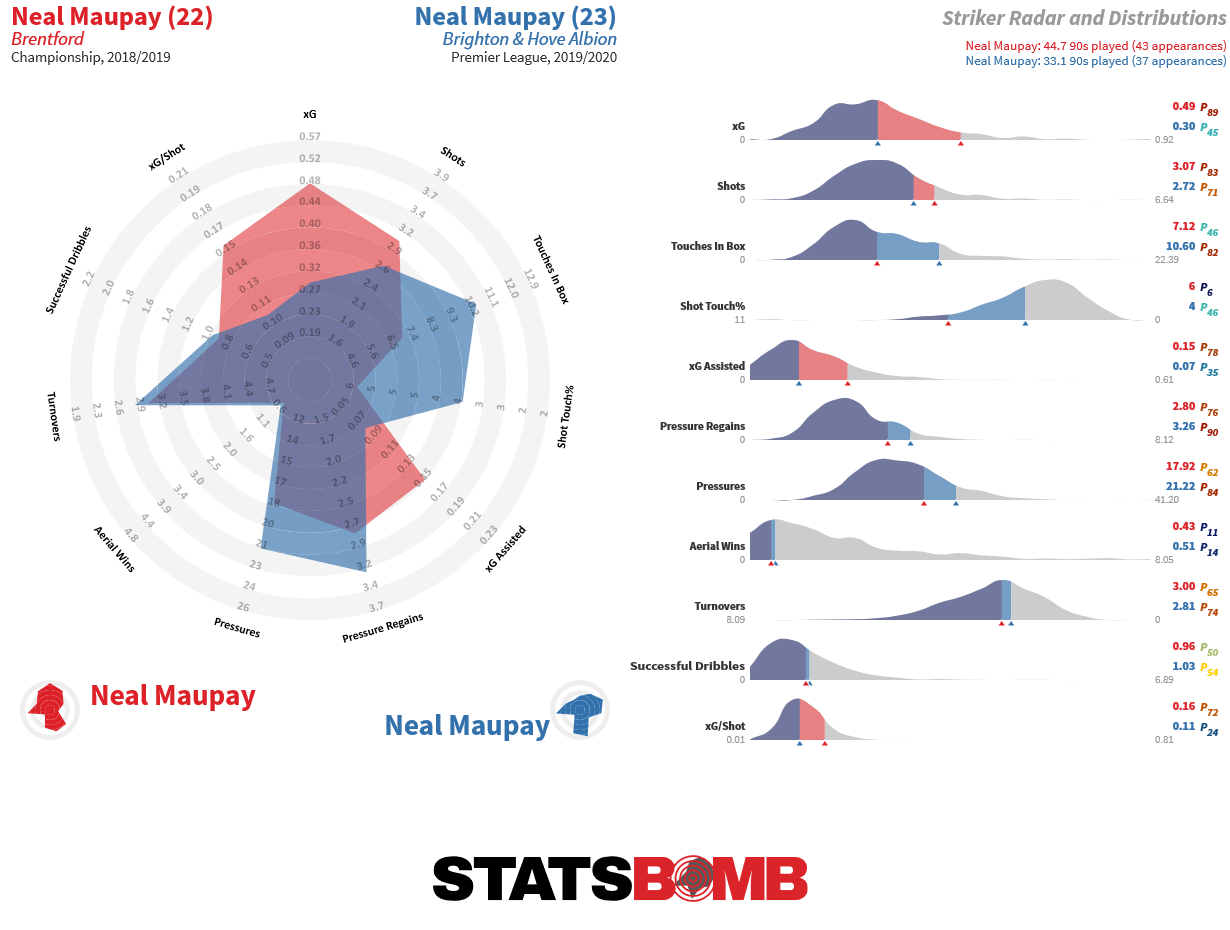
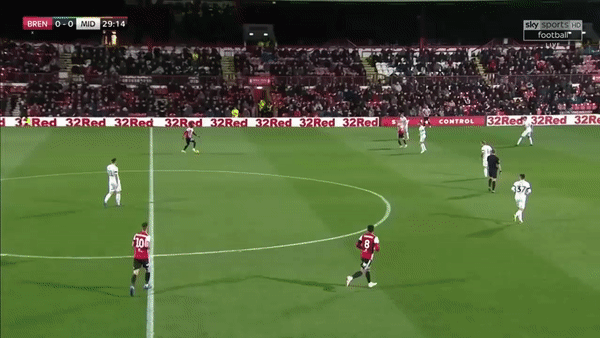
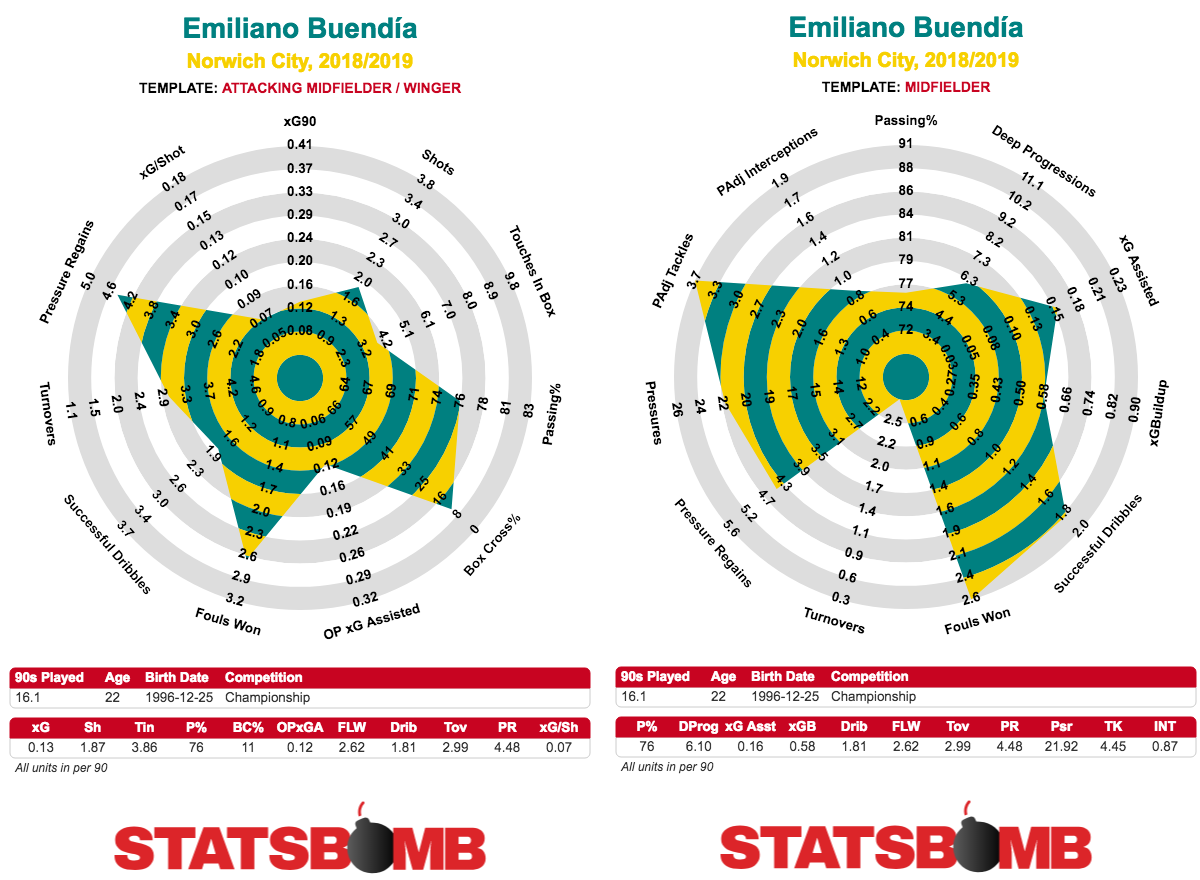
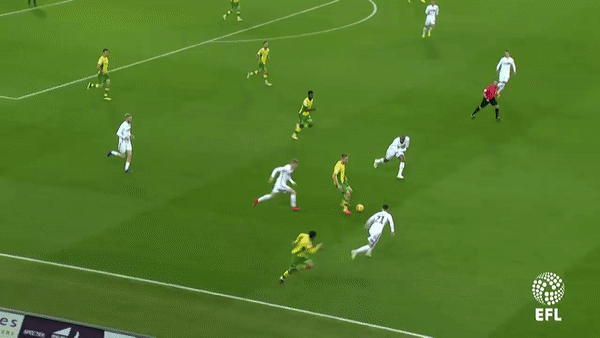
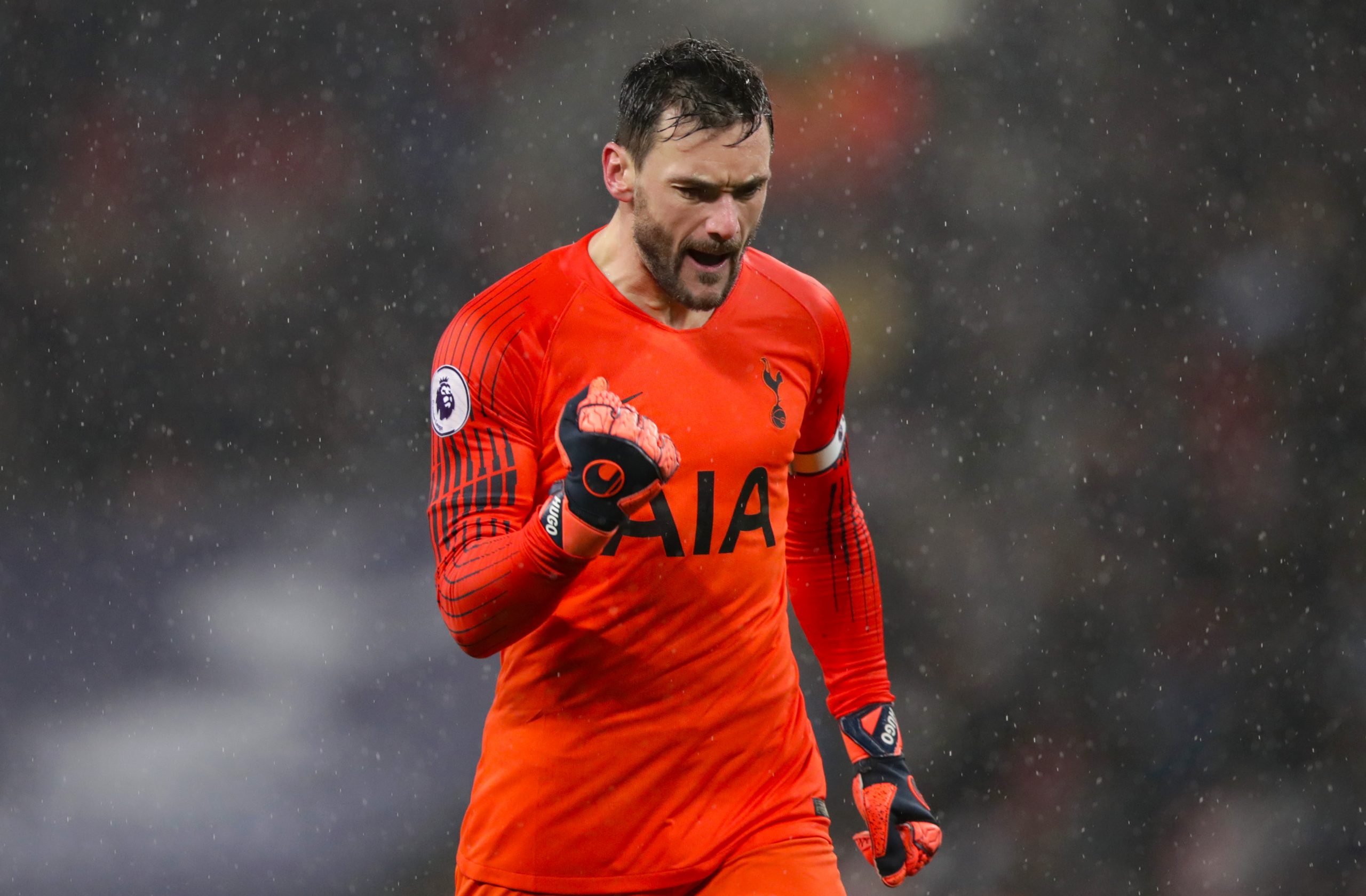
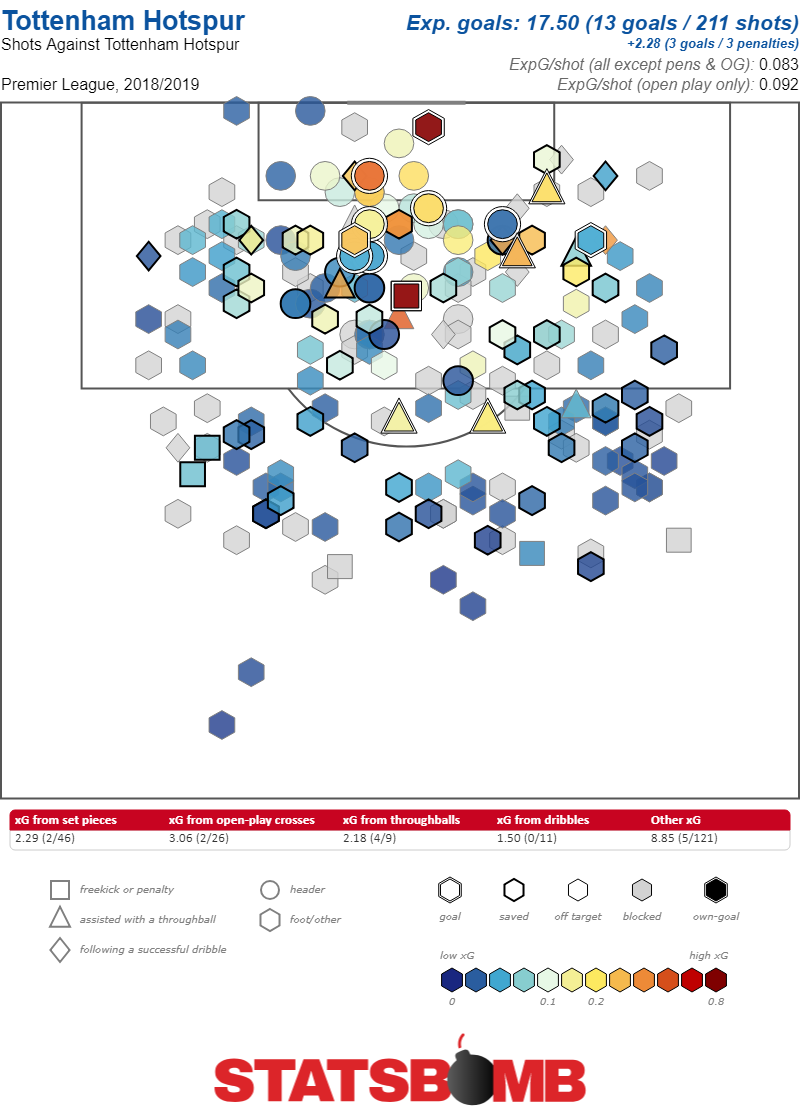 Now, let’s look at Lloris specifically. When he was on the field, basic xG has Spurs well overperforming defensively.
Now, let’s look at Lloris specifically. When he was on the field, basic xG has Spurs well overperforming defensively. 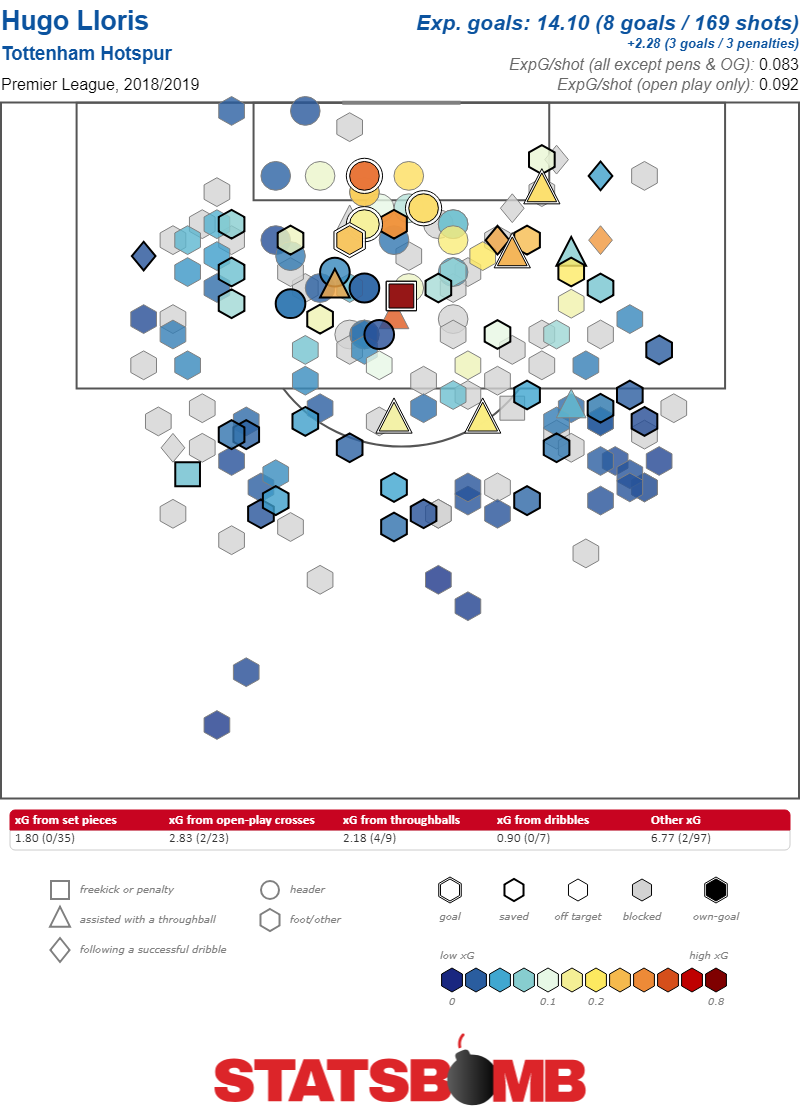 Looking at post-shot xG we see a slightly lower xG total but with Lloris still performing well above average.
Looking at post-shot xG we see a slightly lower xG total but with Lloris still performing well above average. 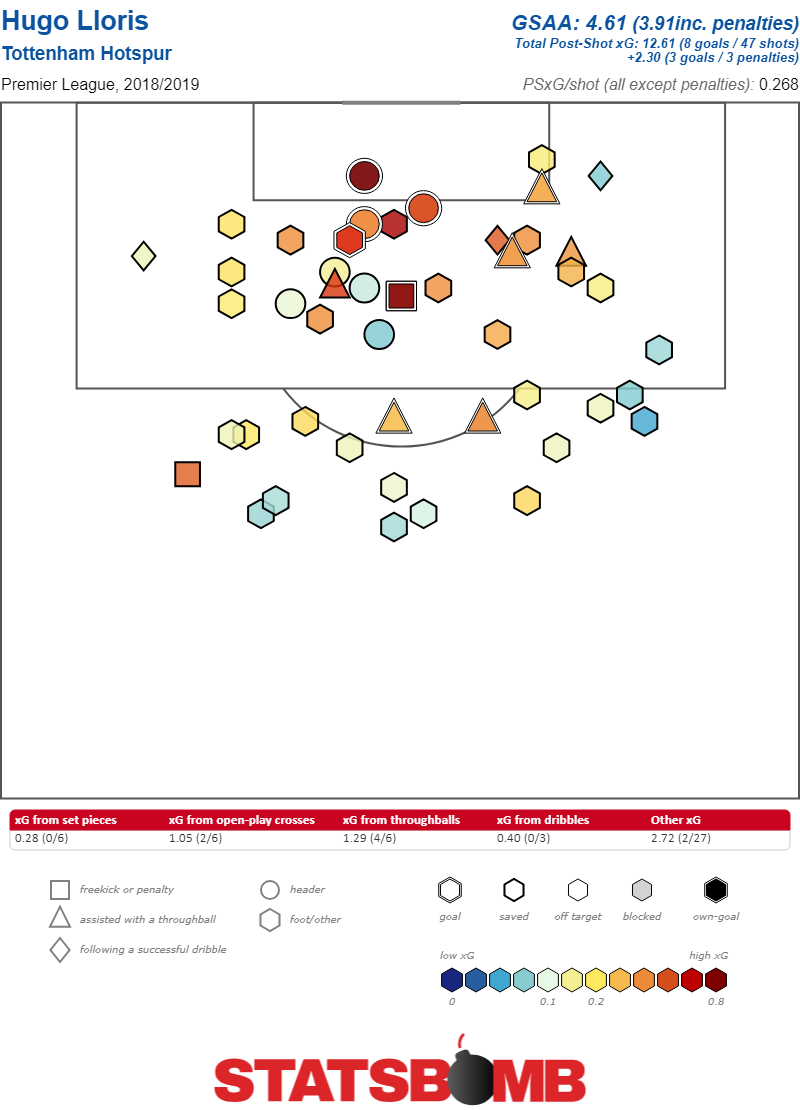 What exactly does that mean? It means that actually the shots against Lloris were slightly easier than a generic xG model predicts they would be. So, somewhat fewer belters towards the corner for Lloris to lunge and tip over, or a couple fewer perfectly placed curlers, and a few more smashed right at him. But that said, Lloris has still saved over 4.5 goals more than an average keeper would have given the shots he’s faced. In fact, as a rate instead of a raw number, Lloris ranks second in the league at Goals Saved Above Average. His GSAA% of 9.8% is only behind Alisson’s 10.7% among first choice Premier League keepers. In the 13 games Lloris has played this year he’s been a huge factor in a very successful Spurs season. The Champions League, of course, is a slightly different story. He played three full matches, and was red carded in a fourth. And his overall performance was below average. His GSAA was below par, letting in 1.69 shots more than a keeper might have on average.
What exactly does that mean? It means that actually the shots against Lloris were slightly easier than a generic xG model predicts they would be. So, somewhat fewer belters towards the corner for Lloris to lunge and tip over, or a couple fewer perfectly placed curlers, and a few more smashed right at him. But that said, Lloris has still saved over 4.5 goals more than an average keeper would have given the shots he’s faced. In fact, as a rate instead of a raw number, Lloris ranks second in the league at Goals Saved Above Average. His GSAA% of 9.8% is only behind Alisson’s 10.7% among first choice Premier League keepers. In the 13 games Lloris has played this year he’s been a huge factor in a very successful Spurs season. The Champions League, of course, is a slightly different story. He played three full matches, and was red carded in a fourth. And his overall performance was below average. His GSAA was below par, letting in 1.69 shots more than a keeper might have on average. 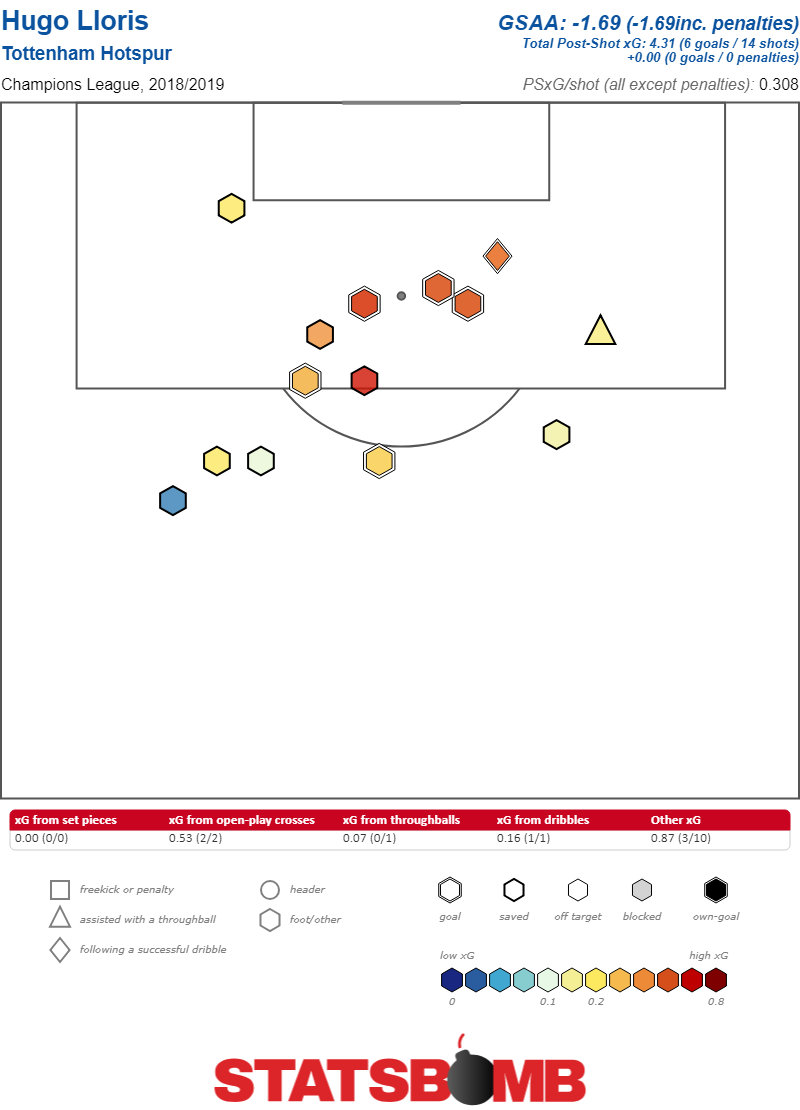 And similarly, last season Lloris put up mediocre results against expectation for Spurs in net. He conceded almost exactly at hist GSAA average. An interesting note about Lloris’s year over year performance is that his expected save percentage was remarkably similar last season, 73.8% to this, 73.2%. That means that his improvement this season is accurately captured by his raw save percentage number in creasing from 73.4% to 83%. It also gives us a little more information about the contours of Spurs decline in defensive performance, namely that it’s a volume issue, and sure enough Spurs are giving up more than 2.5 shots per game more this year, 12.41, more than last year, 9.87
And similarly, last season Lloris put up mediocre results against expectation for Spurs in net. He conceded almost exactly at hist GSAA average. An interesting note about Lloris’s year over year performance is that his expected save percentage was remarkably similar last season, 73.8% to this, 73.2%. That means that his improvement this season is accurately captured by his raw save percentage number in creasing from 73.4% to 83%. It also gives us a little more information about the contours of Spurs decline in defensive performance, namely that it’s a volume issue, and sure enough Spurs are giving up more than 2.5 shots per game more this year, 12.41, more than last year, 9.87  So, how to reconcile all this. The easy thing to say is that this season in the Premier League Lloris has been excellent, at a time when Spurs needed him to be. Projecting that performance out into the future is harder. Part of this is because this data is so new, we don’t know how it is supposed to behave. We don’t know, for example, if the fact that Lloris was so far above expectations last year was in fact a red flag indicating that maybe he was performing at a level that couldn’t continue (similar to how great goal scorers, even if they might be expected to marginally outperform regular old xG, don’t do so consistently by nearly as much as they do in their best moments). Or, maybe actually Lloris consistently has outperformed his GSAA for years and years and years and we just don’t have the historical data that shows us that. Maybe last year was the anomaly, and not only do keepers frequently diverge from GSAA, but they do it in really sustainable ways over large swathes of their career. If that was the case, and last year was the weird one, then there’d by absolutely nothing for Spurs to worry about at all. This season, with all the shot stopping, would just be a return to business as usual. There’s a considerable amount of uncertainty around Lloris, and consequently around the rest of Spurs Premier League season. But, one thing that we can say for sure is that in the thirteen games he’s played this year he’s been excellent, almost as good as any keeper in the Premier League. And Spurs have needed him to be. Without Lloris, Spurs strong start to the season wouldn’t have happened. The question now is will Lloris slow down, and will Spurs be able to keep thriving if he does? Header image courtesy of the Press Association
So, how to reconcile all this. The easy thing to say is that this season in the Premier League Lloris has been excellent, at a time when Spurs needed him to be. Projecting that performance out into the future is harder. Part of this is because this data is so new, we don’t know how it is supposed to behave. We don’t know, for example, if the fact that Lloris was so far above expectations last year was in fact a red flag indicating that maybe he was performing at a level that couldn’t continue (similar to how great goal scorers, even if they might be expected to marginally outperform regular old xG, don’t do so consistently by nearly as much as they do in their best moments). Or, maybe actually Lloris consistently has outperformed his GSAA for years and years and years and we just don’t have the historical data that shows us that. Maybe last year was the anomaly, and not only do keepers frequently diverge from GSAA, but they do it in really sustainable ways over large swathes of their career. If that was the case, and last year was the weird one, then there’d by absolutely nothing for Spurs to worry about at all. This season, with all the shot stopping, would just be a return to business as usual. There’s a considerable amount of uncertainty around Lloris, and consequently around the rest of Spurs Premier League season. But, one thing that we can say for sure is that in the thirteen games he’s played this year he’s been excellent, almost as good as any keeper in the Premier League. And Spurs have needed him to be. Without Lloris, Spurs strong start to the season wouldn’t have happened. The question now is will Lloris slow down, and will Spurs be able to keep thriving if he does? Header image courtesy of the Press Association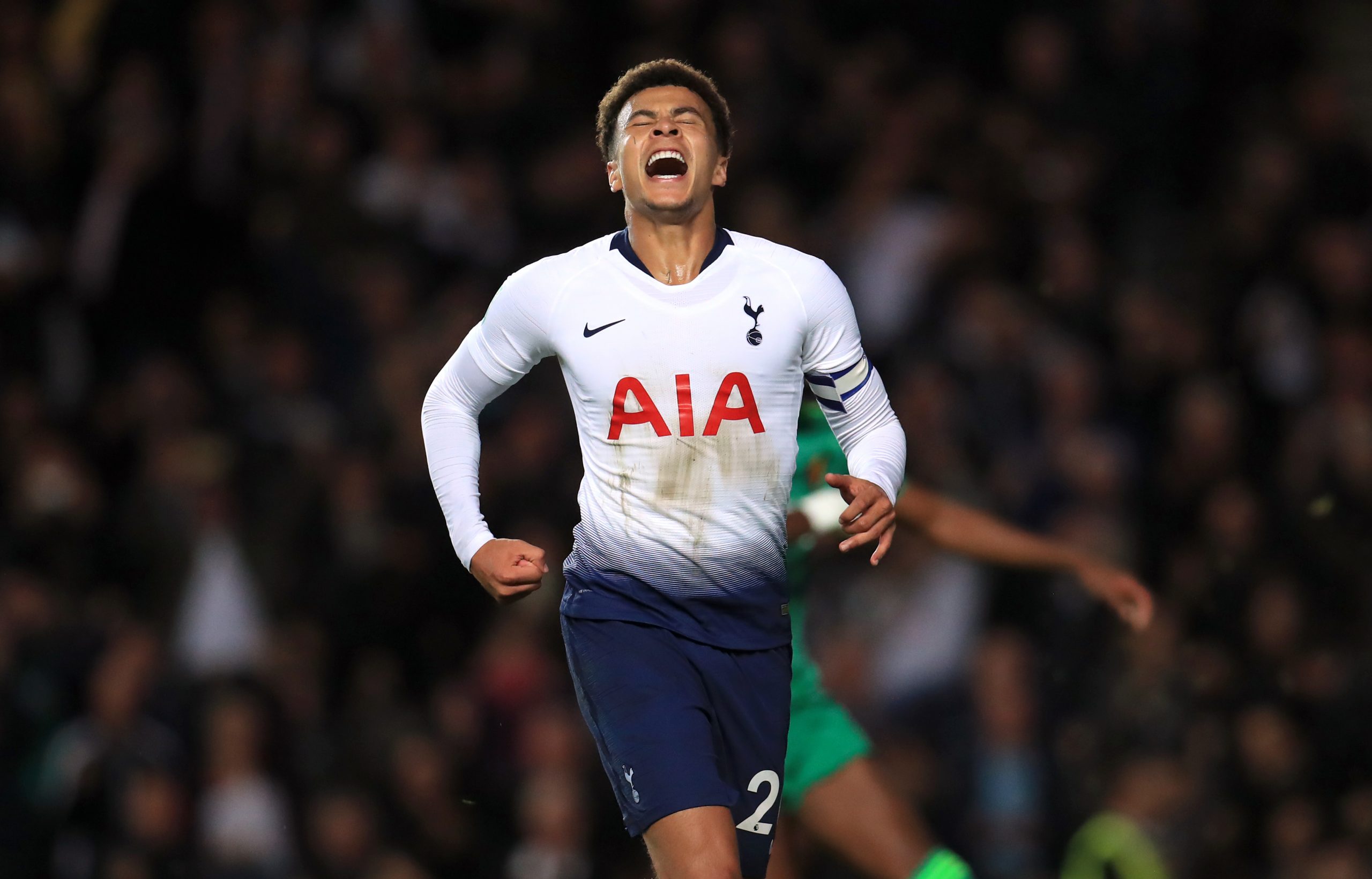
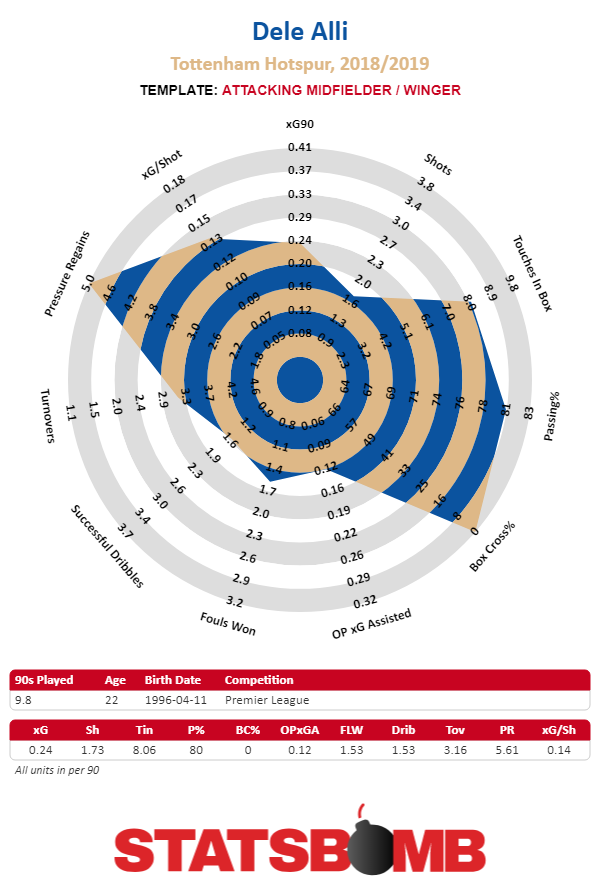 In the three and a bit years since making his Tottenham Hotspur debut it feels like Dele Alli hasn't stopped. He's clocked up almost ten thousand minutes of Premier League football. He's scored forty league goals. Thirty-six of those goals, along with twenty-five assists, came in his first one hundred games in the top flight - making him faster out of the blocks than illustrious predecessors such as Frank Lampard and Steven Gerrard. He's got thirty-three international caps for England and scored in the World Cup earlier this year. He glides, shark like, across pitches. Not stopping. Sniffing out space. Smelling blood. He can seem to be on the periphery but is rarely peripheral. He's picked up back to back PFA Young Player of the Year awards. Almost every weekend he's let that cool smirk play across his lips, baiting opposition fans. He's arrived with impeccable timing in penalty boxes over and over again. He's played the pantomime villain: nipping in to steal away second balls, the crowd warning in vain; "He's behind you!". He's been performing in big games since his North London derby debut as a teenager. Lately, such as against Leicester, he has impressed in games when key teammates are rested. The twenty-two year old's insouciant nature with the ball at his feet belies his full pelt race towards progress as a player. Is he a goal scorer? A raumdeuter? An elite disruptor? A ball progressor? A do-it-all 10? As top level goalkeepers and centre backs begin to contribute more to attack and attackers are expected to be able to defend is Dele part of the next evolution? What even is an attacking midfielder in 2018/19? Is he England's most modern player - a multi-functional, protean midfielder?
In the three and a bit years since making his Tottenham Hotspur debut it feels like Dele Alli hasn't stopped. He's clocked up almost ten thousand minutes of Premier League football. He's scored forty league goals. Thirty-six of those goals, along with twenty-five assists, came in his first one hundred games in the top flight - making him faster out of the blocks than illustrious predecessors such as Frank Lampard and Steven Gerrard. He's got thirty-three international caps for England and scored in the World Cup earlier this year. He glides, shark like, across pitches. Not stopping. Sniffing out space. Smelling blood. He can seem to be on the periphery but is rarely peripheral. He's picked up back to back PFA Young Player of the Year awards. Almost every weekend he's let that cool smirk play across his lips, baiting opposition fans. He's arrived with impeccable timing in penalty boxes over and over again. He's played the pantomime villain: nipping in to steal away second balls, the crowd warning in vain; "He's behind you!". He's been performing in big games since his North London derby debut as a teenager. Lately, such as against Leicester, he has impressed in games when key teammates are rested. The twenty-two year old's insouciant nature with the ball at his feet belies his full pelt race towards progress as a player. Is he a goal scorer? A raumdeuter? An elite disruptor? A ball progressor? A do-it-all 10? As top level goalkeepers and centre backs begin to contribute more to attack and attackers are expected to be able to defend is Dele part of the next evolution? What even is an attacking midfielder in 2018/19? Is he England's most modern player - a multi-functional, protean midfielder? 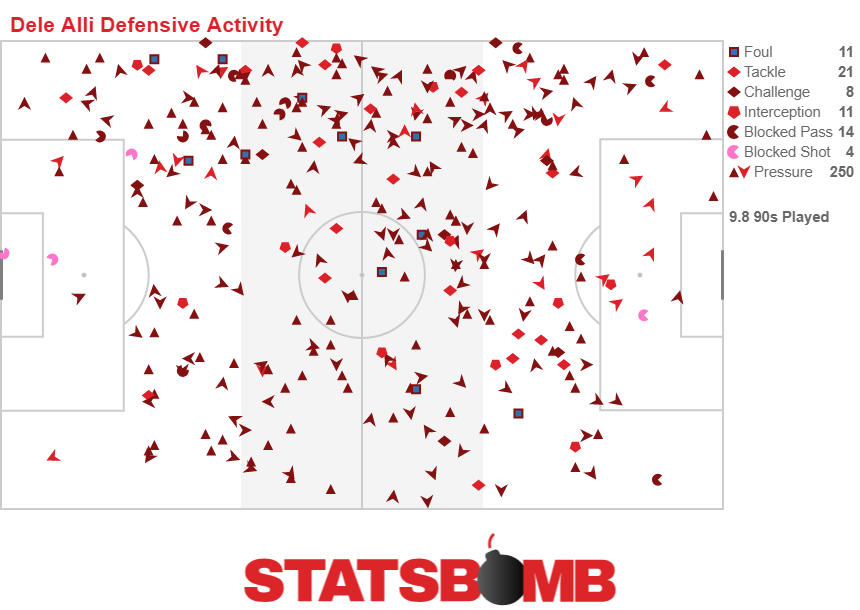 This season Dele has really dialed up the amount of pressure he applies to opposition players. It has been effective, resulting in a huge amount of pressure regains for his team. On average Spurs win the ball back over five times every single match within five seconds of Dele pressuring an opponent. Players with elite destructive traits such as N'Golo Kante and Sergio Busquets are forcing fewer pressure regains than that this season. Dele is also attempting almost twice as many tackles compared to last season and, impressively, is winning almost three quarters of them. His leggy build and masterful powers of anticipation are a tough combination for opposition players especially in tight areas during moments of transition. As well as disrupting opponents, Dele reduces the pressure experienced by his teammates. He's a great out ball - receiving the most passes when under pressure in this Spurs team. Once he's got the ball he doesn't just shift responsibility onto someone else in a similarly tough spot. Out of the entire Spurs squad he only plays the sixth most passes to a teammate under pressure. Interestingly this is quite a change from last season. When it comes to applying and relieving pressure Dele really seems to be developing.
This season Dele has really dialed up the amount of pressure he applies to opposition players. It has been effective, resulting in a huge amount of pressure regains for his team. On average Spurs win the ball back over five times every single match within five seconds of Dele pressuring an opponent. Players with elite destructive traits such as N'Golo Kante and Sergio Busquets are forcing fewer pressure regains than that this season. Dele is also attempting almost twice as many tackles compared to last season and, impressively, is winning almost three quarters of them. His leggy build and masterful powers of anticipation are a tough combination for opposition players especially in tight areas during moments of transition. As well as disrupting opponents, Dele reduces the pressure experienced by his teammates. He's a great out ball - receiving the most passes when under pressure in this Spurs team. Once he's got the ball he doesn't just shift responsibility onto someone else in a similarly tough spot. Out of the entire Spurs squad he only plays the sixth most passes to a teammate under pressure. Interestingly this is quite a change from last season. When it comes to applying and relieving pressure Dele really seems to be developing. 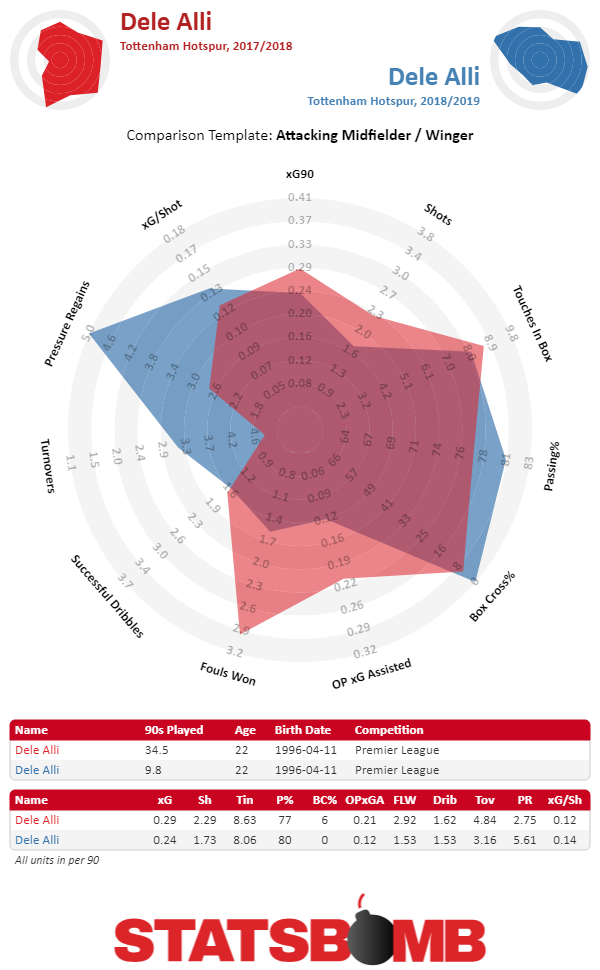
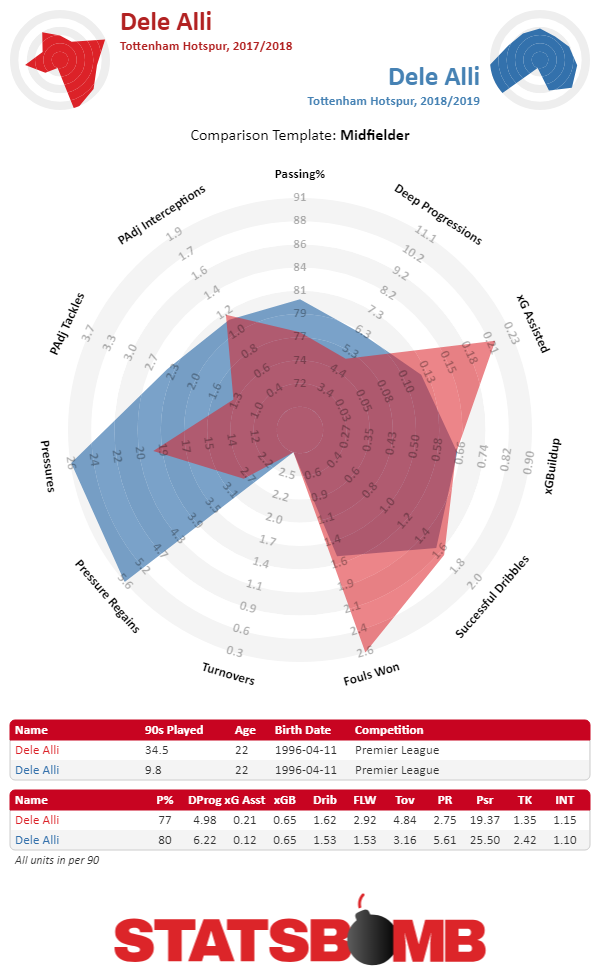
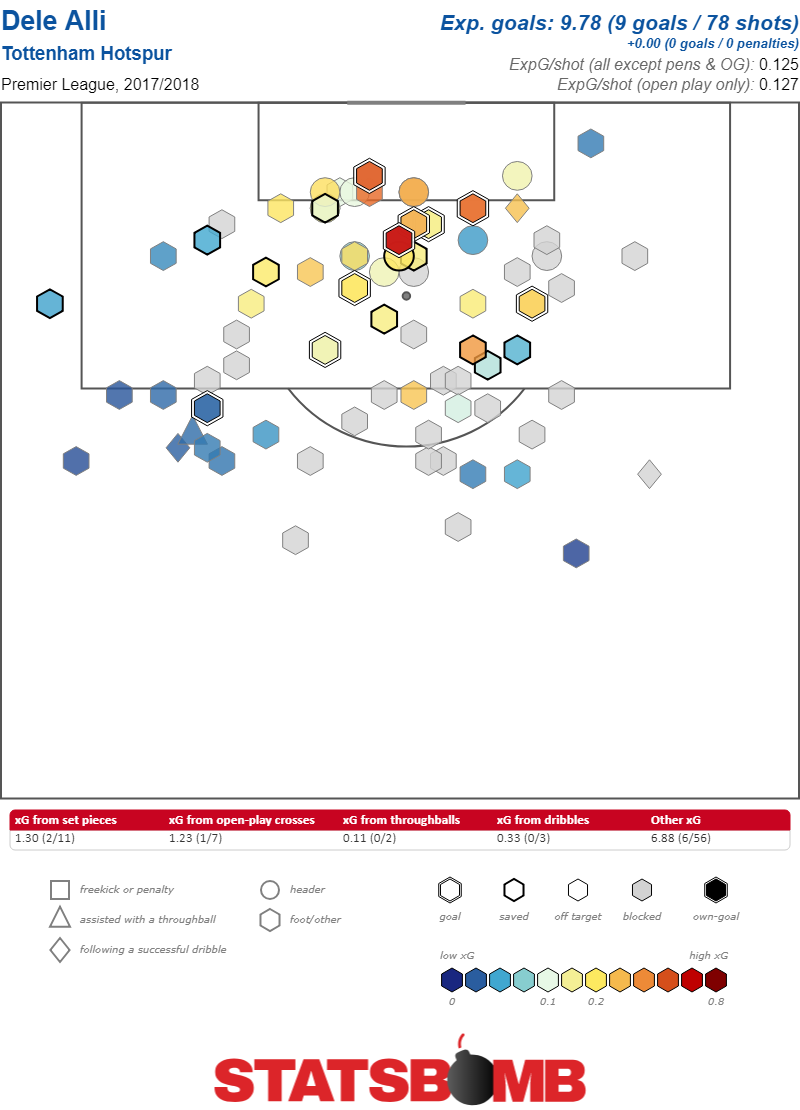
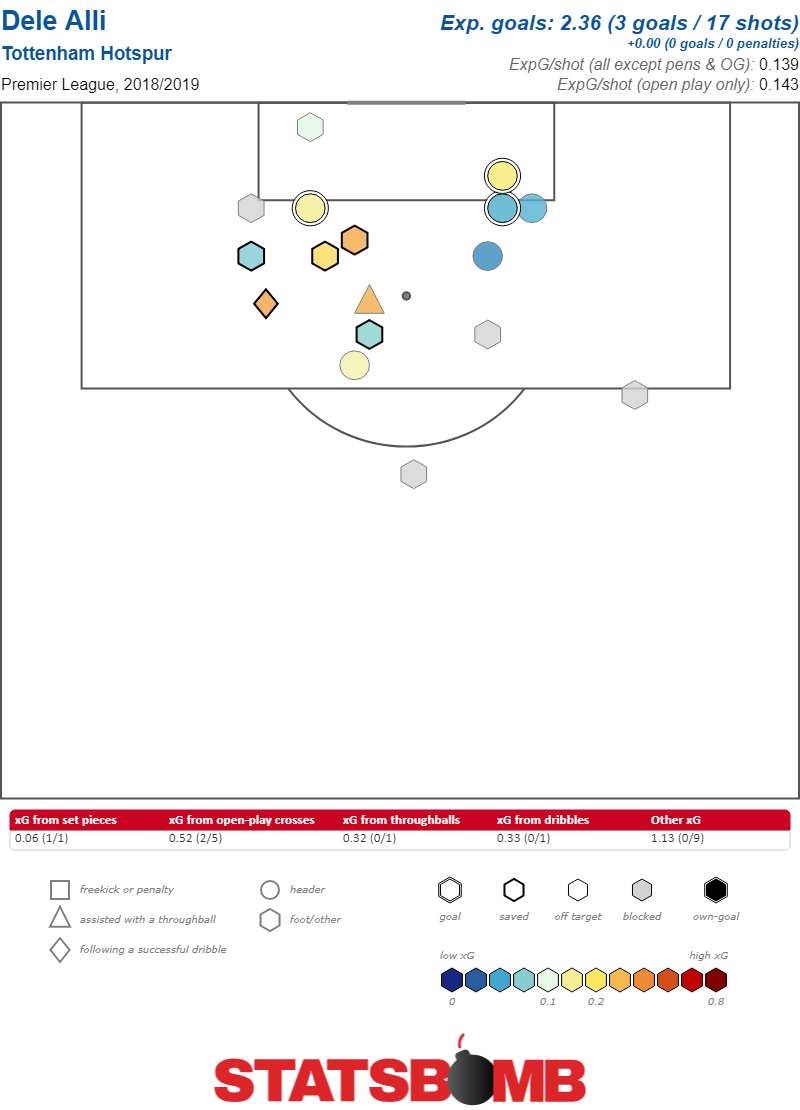 In terms of Dele's own shooting this may indicate further evolution. It looks like he is making smarter choices given the comparative lack of low value efforts from outside the box. A quick caveat would be that each of his league goals so far this season have been headers. It'll be worth keeping an eye on whether he can generate as many close range attempts with his feet throughout the remainder of this season as he has in the past. For now though his xG per 90 is similar to that of last season and he'd probably be on track to score into double digits this season if not for his hamstring injuries through September and October. All of this adds up to a seriously dangerous player. There are not many other players in the Premier League that help win the ball, progress it into dangerous areas and then provide a goal threat quite like him.
In terms of Dele's own shooting this may indicate further evolution. It looks like he is making smarter choices given the comparative lack of low value efforts from outside the box. A quick caveat would be that each of his league goals so far this season have been headers. It'll be worth keeping an eye on whether he can generate as many close range attempts with his feet throughout the remainder of this season as he has in the past. For now though his xG per 90 is similar to that of last season and he'd probably be on track to score into double digits this season if not for his hamstring injuries through September and October. All of this adds up to a seriously dangerous player. There are not many other players in the Premier League that help win the ball, progress it into dangerous areas and then provide a goal threat quite like him. 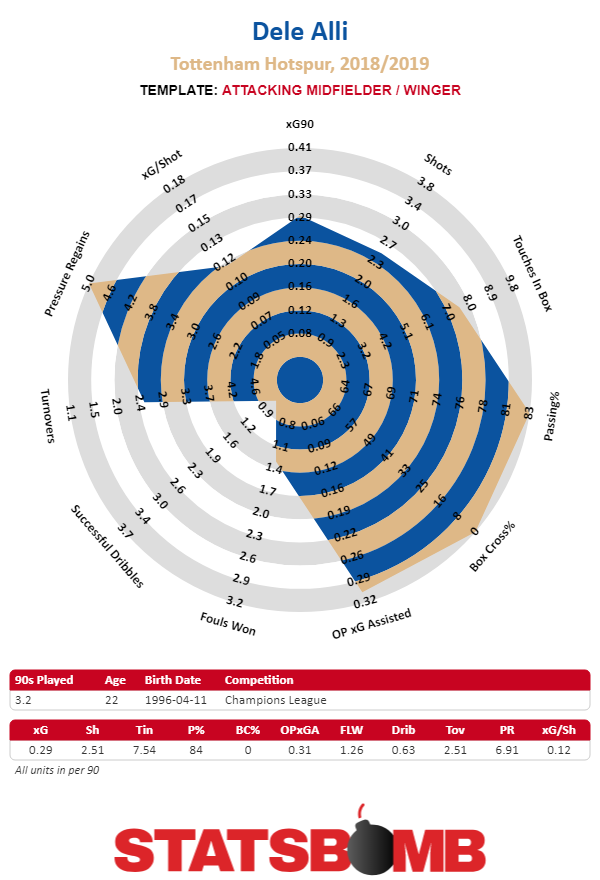 Dele's limited Champions League minutes show a brighter picture this season in terms of chance creation. As Spurs acclimatize to a more possession oriented style in the Premier League and work to develop more controlled methods of progressing the ball into the final third it may be that Dele gets the opportunity to provide more opportunities for his teammates. Certainly there is no question over his ability to do so. The question is really: what can't he do?
Dele's limited Champions League minutes show a brighter picture this season in terms of chance creation. As Spurs acclimatize to a more possession oriented style in the Premier League and work to develop more controlled methods of progressing the ball into the final third it may be that Dele gets the opportunity to provide more opportunities for his teammates. Certainly there is no question over his ability to do so. The question is really: what can't he do? 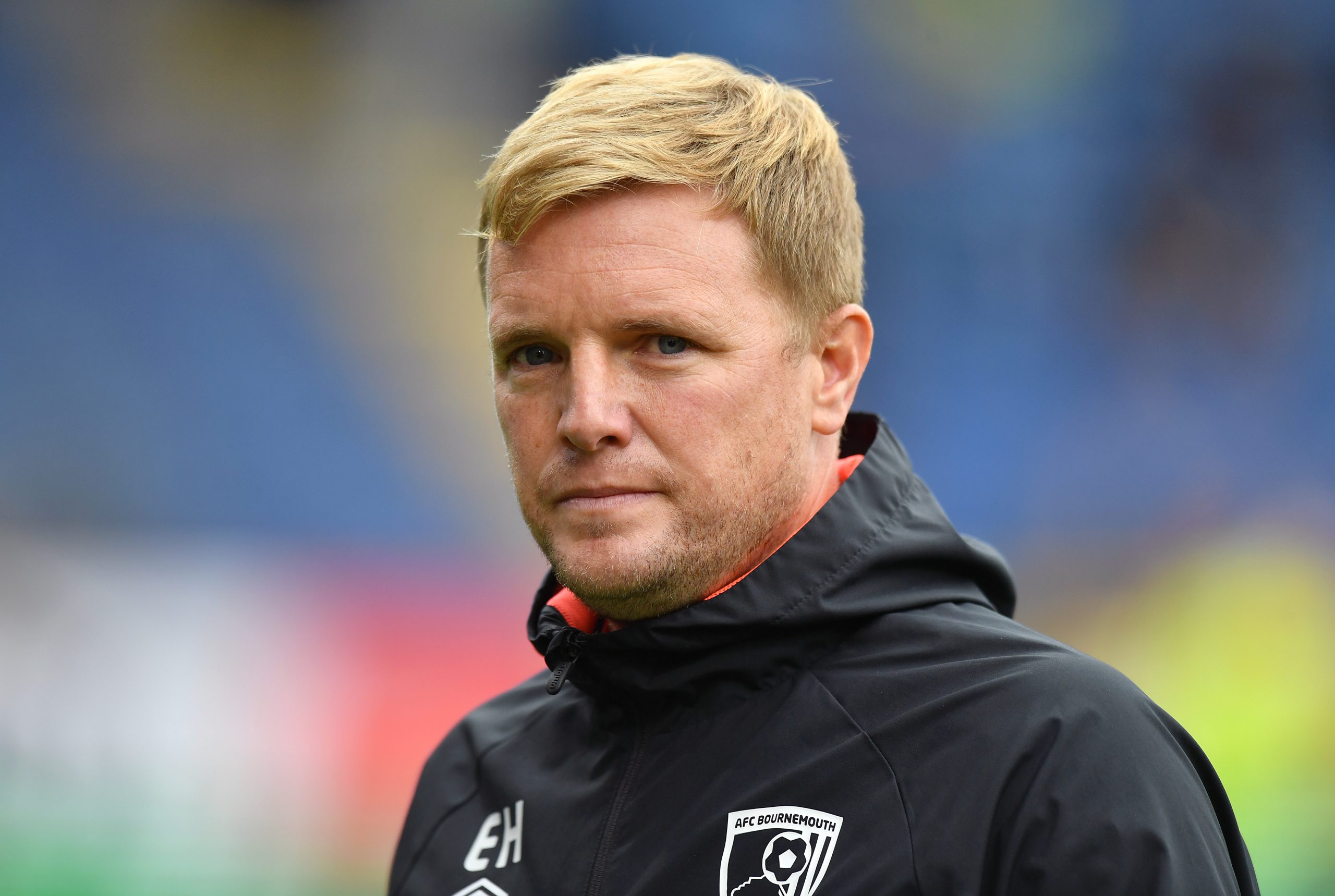
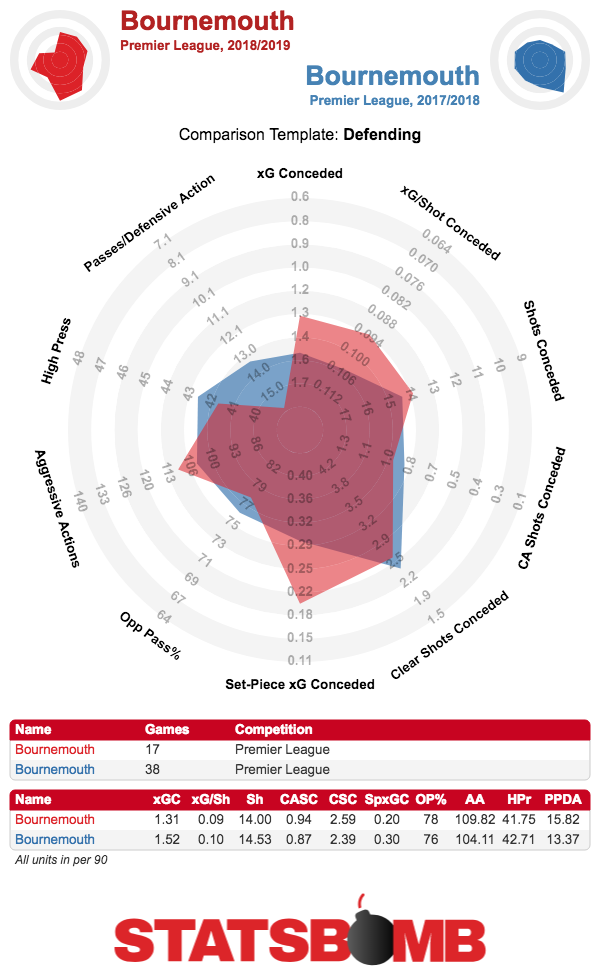
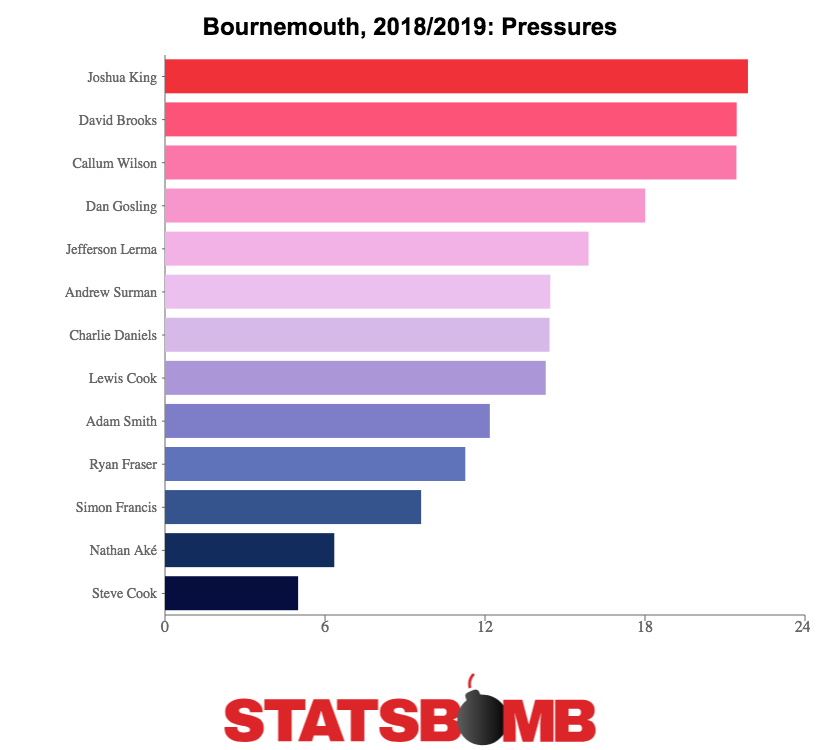
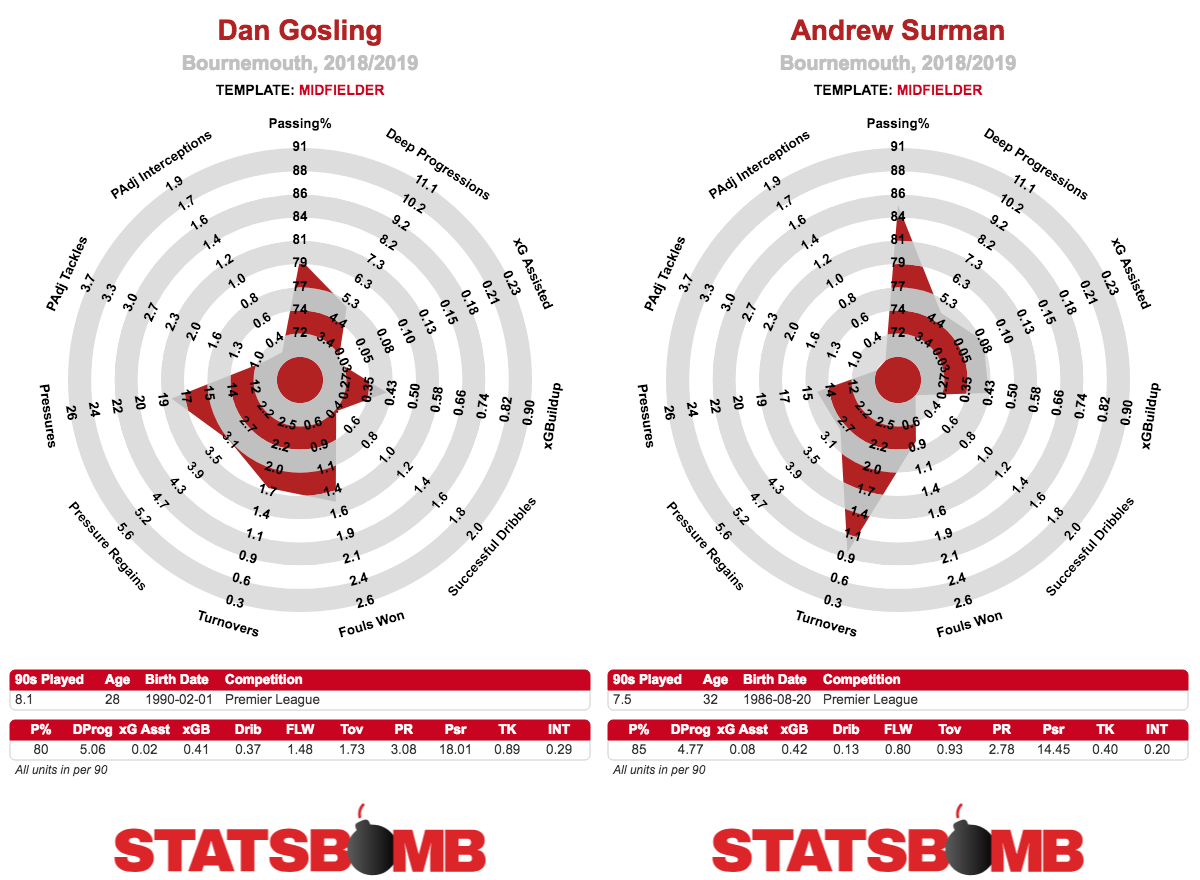
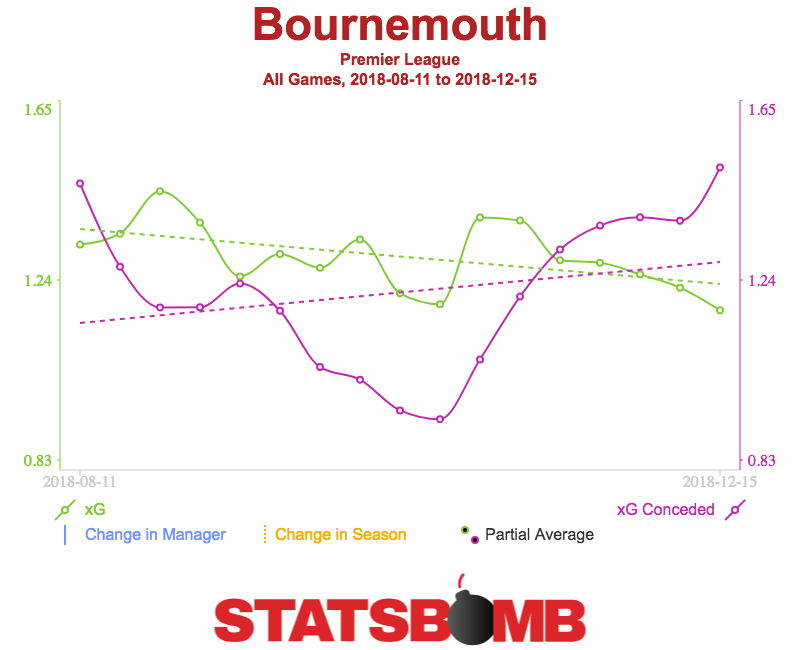
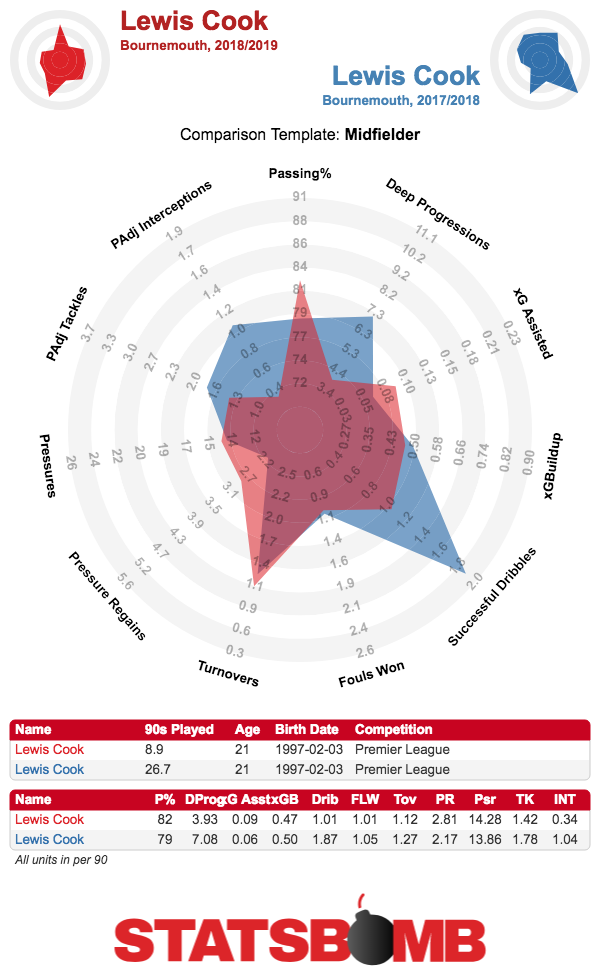
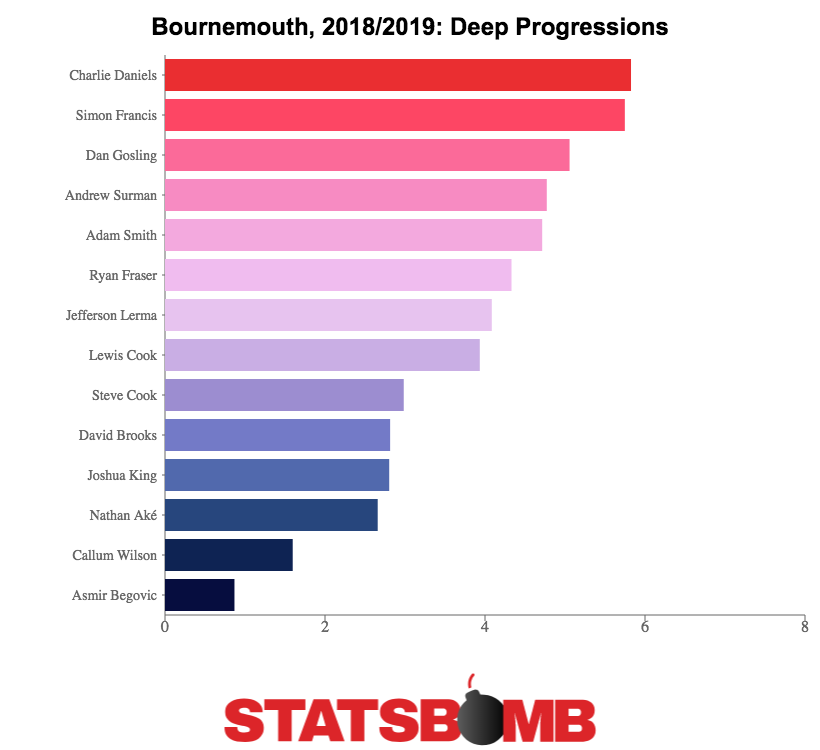
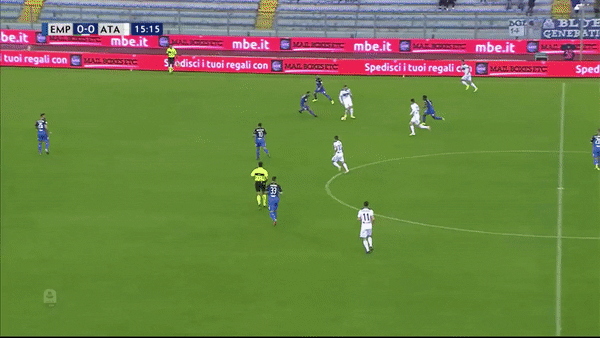
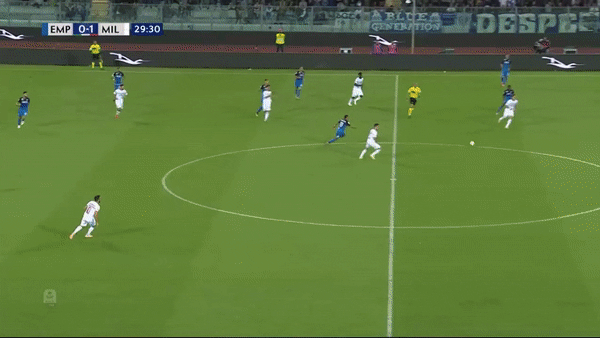
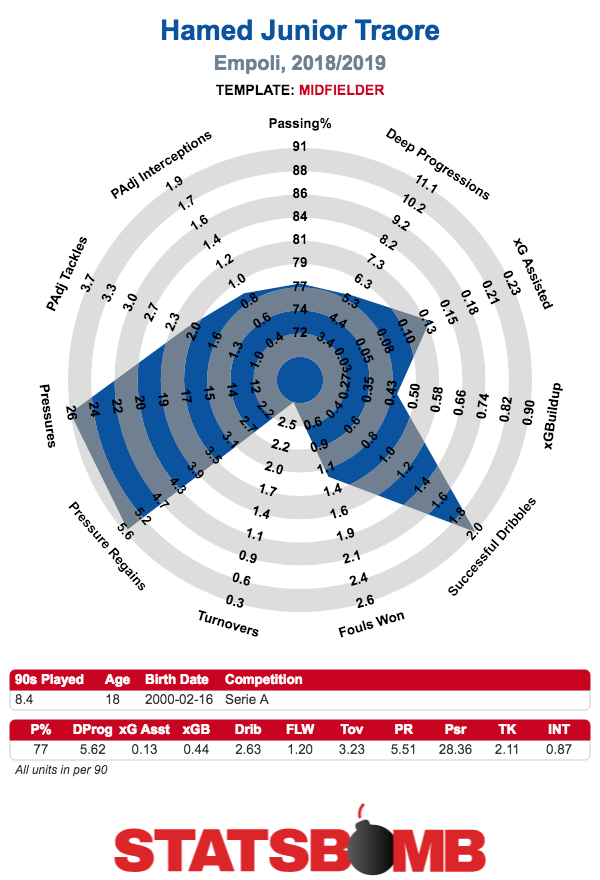

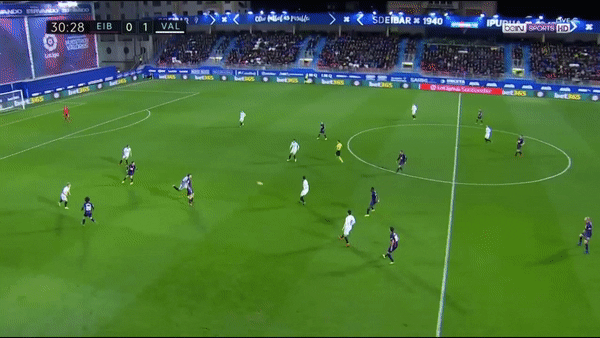 Jordan may not have the same upside that Traore does based on their respective skillsets and the fact he's more than five years older and it’s fair to wonder if Jordan can translate his two-way production to a higher tempo league given he’s not the quickest player out there, but given the probable cheap price and Jordan’s ability to sprinkle in goals and assists as a midfielder, it’s a low risk/medium reward transfer that could conceivably become a net positive.
Jordan may not have the same upside that Traore does based on their respective skillsets and the fact he's more than five years older and it’s fair to wonder if Jordan can translate his two-way production to a higher tempo league given he’s not the quickest player out there, but given the probable cheap price and Jordan’s ability to sprinkle in goals and assists as a midfielder, it’s a low risk/medium reward transfer that could conceivably become a net positive. 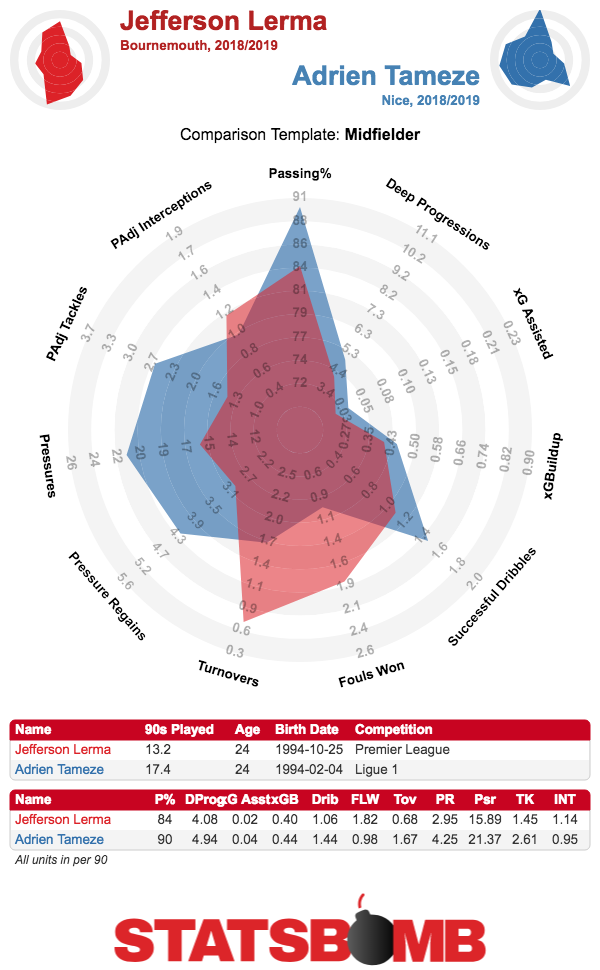
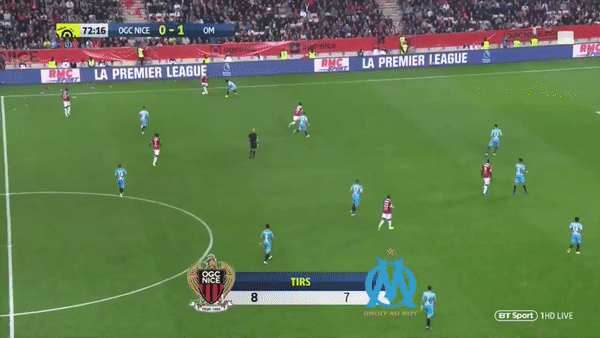
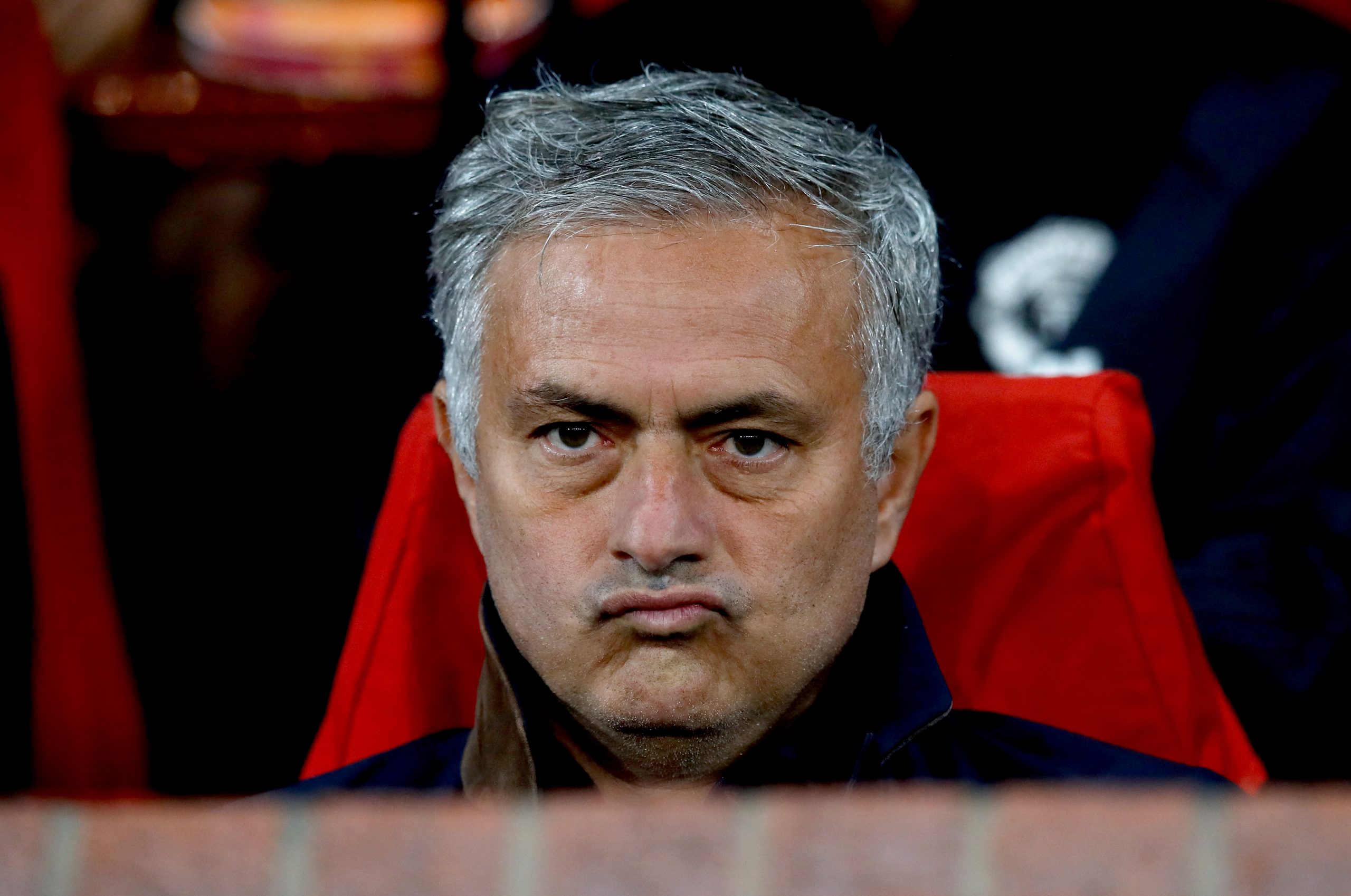

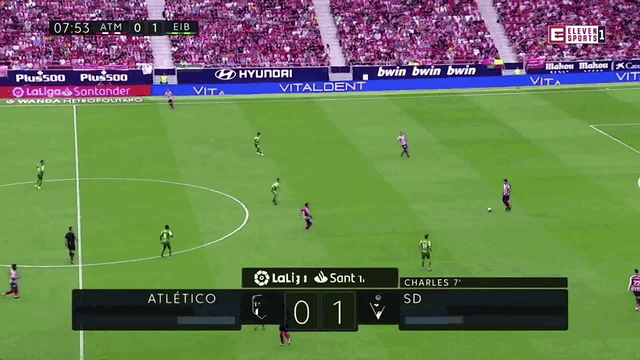




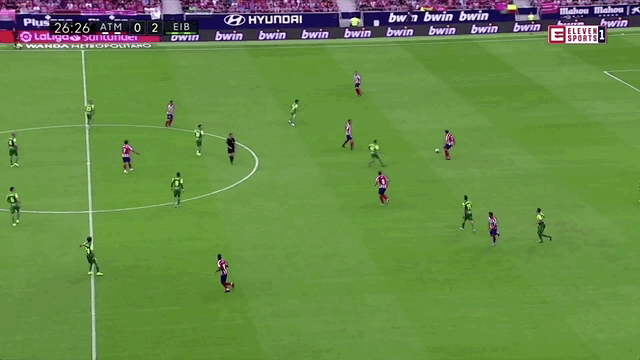



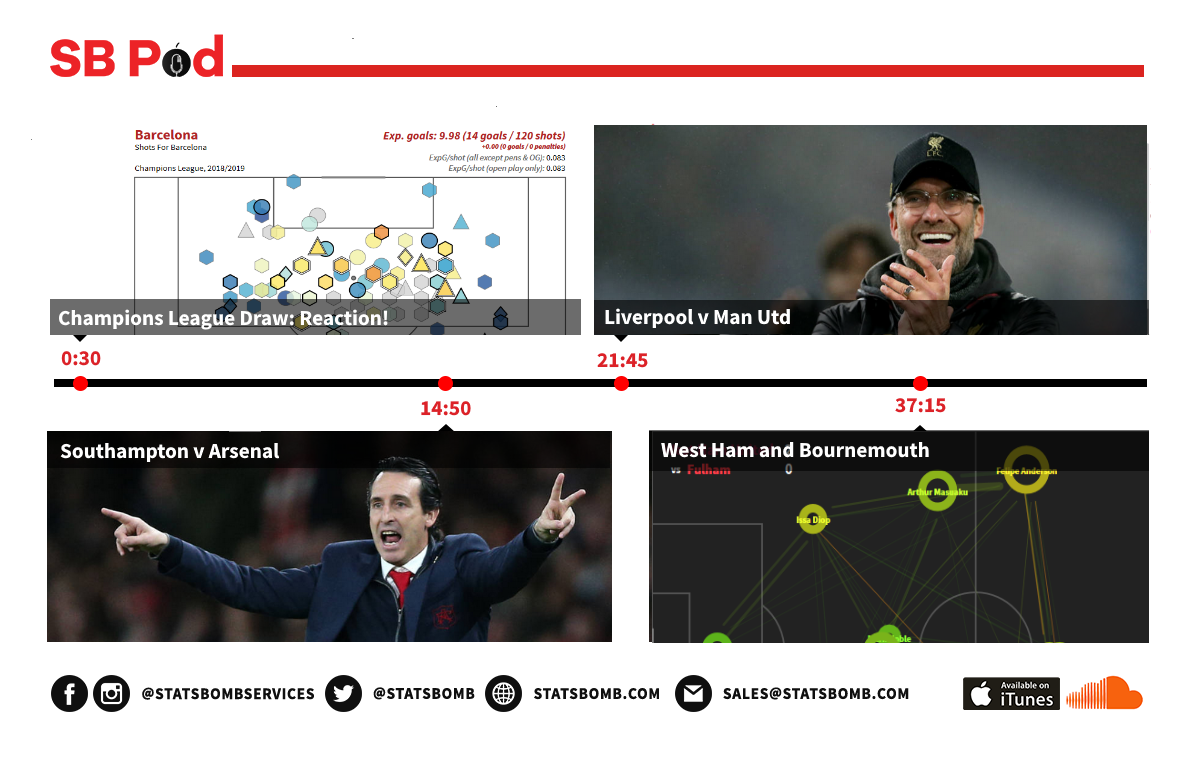
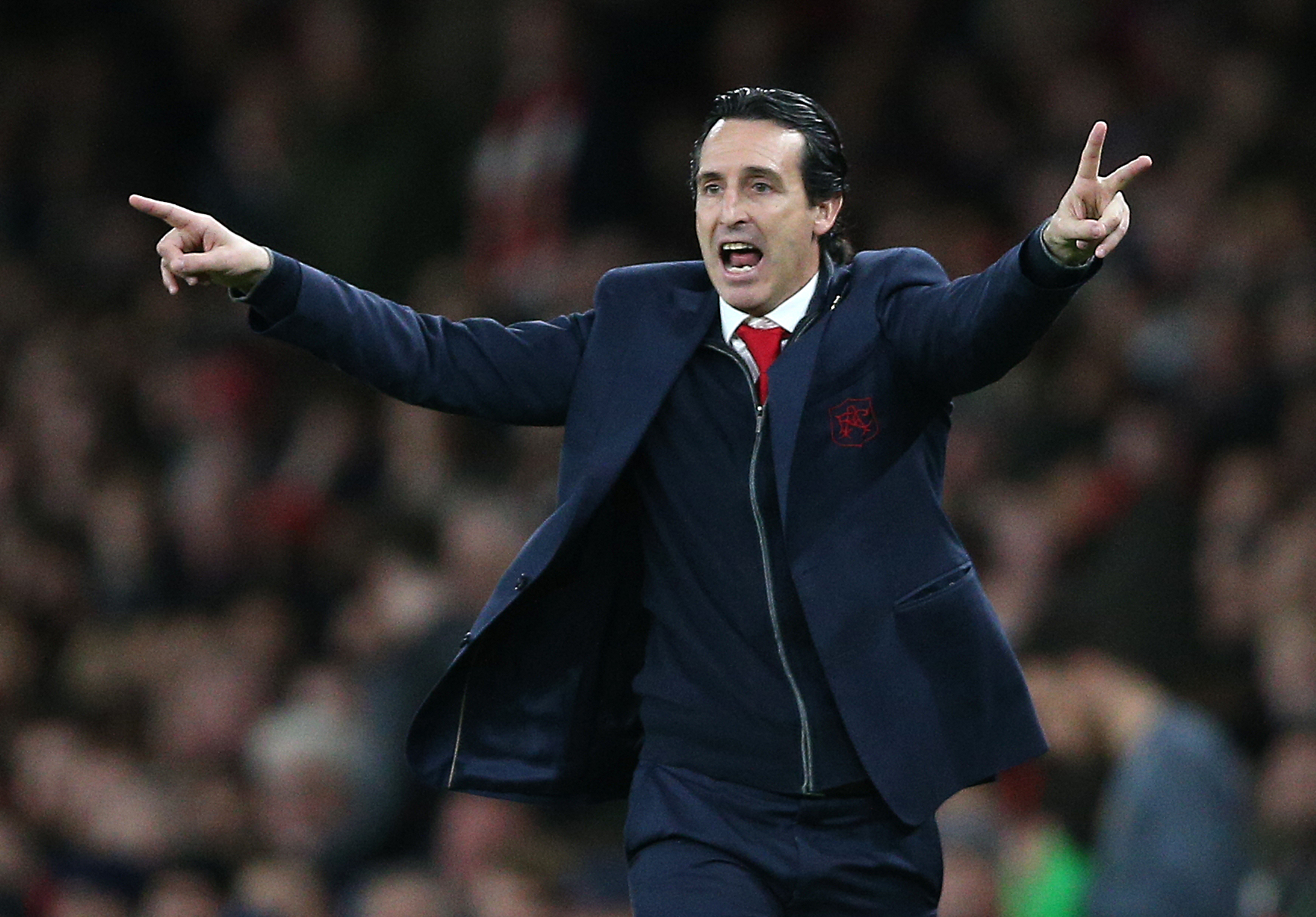
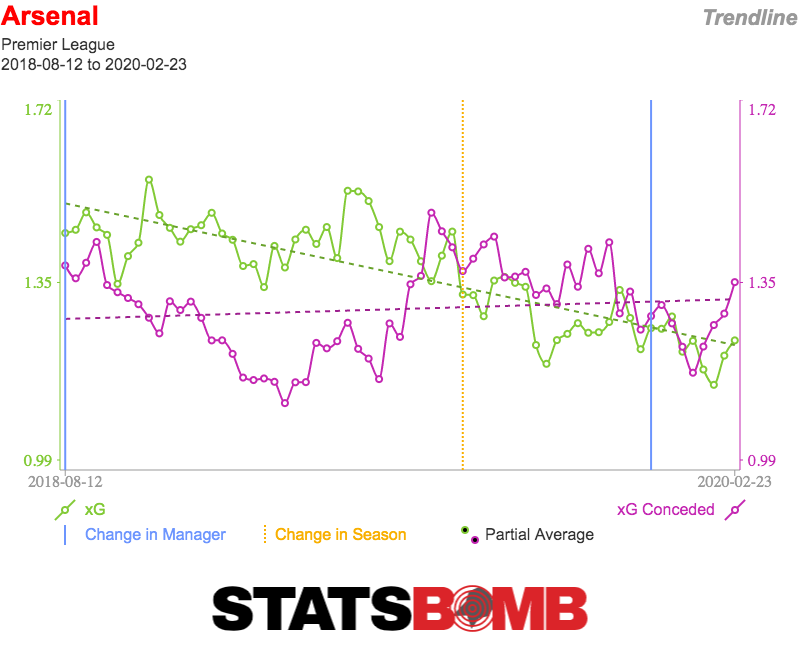 If there’s reason for concern it’s not in the bottom line. Fifth best by numbers, in the top four race and moving in the right direction might still be short of Arsenal’s ultimate ambitions but it’s a fine place to be approaching the midway point of Arsenal’s first season under new management. But, how they’re doing it is…well it’s weird. Arsenal’s success is coming despite not having led a single game at halftime. Does that mean anything? Is it just the football gods playing with Gunner emotions? Or is there something going on under the hood with Arsenal that’s leading to this exceedingly odd outcome? If there is some real tactical reason for the lopsidedness of Arsenal’s performance is it good or bad? Is Emery displaying the tactical acumen to rescue his teams from weak performances, or is he hampering them in the first half before getting out of the way later on? It does at least seem as if there’s something substantively different about Arsenal’s performances half to half. Here is Arsenal’s attacking output in the first half of games this season.
If there’s reason for concern it’s not in the bottom line. Fifth best by numbers, in the top four race and moving in the right direction might still be short of Arsenal’s ultimate ambitions but it’s a fine place to be approaching the midway point of Arsenal’s first season under new management. But, how they’re doing it is…well it’s weird. Arsenal’s success is coming despite not having led a single game at halftime. Does that mean anything? Is it just the football gods playing with Gunner emotions? Or is there something going on under the hood with Arsenal that’s leading to this exceedingly odd outcome? If there is some real tactical reason for the lopsidedness of Arsenal’s performance is it good or bad? Is Emery displaying the tactical acumen to rescue his teams from weak performances, or is he hampering them in the first half before getting out of the way later on? It does at least seem as if there’s something substantively different about Arsenal’s performances half to half. Here is Arsenal’s attacking output in the first half of games this season. 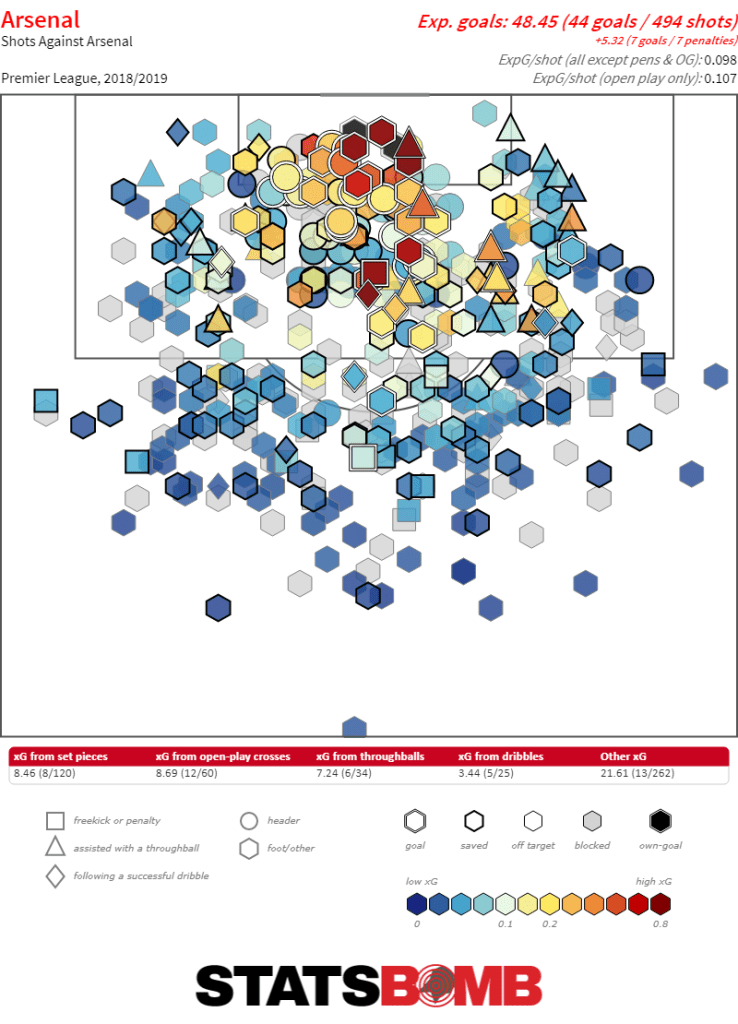 There’s not a lot to write home about there. It’s fine. Eight goals is about what you’d expect from the shots they’re taking. Their xG per shot is an unimpressive 0.086 which is why even though 97 shots total which works out to a 12 per match pace isn’t terrible, their xG is so uninspiring. It’s all just kind of meh. But, after the break, things improve dramatically.
There’s not a lot to write home about there. It’s fine. Eight goals is about what you’d expect from the shots they’re taking. Their xG per shot is an unimpressive 0.086 which is why even though 97 shots total which works out to a 12 per match pace isn’t terrible, their xG is so uninspiring. It’s all just kind of meh. But, after the break, things improve dramatically. 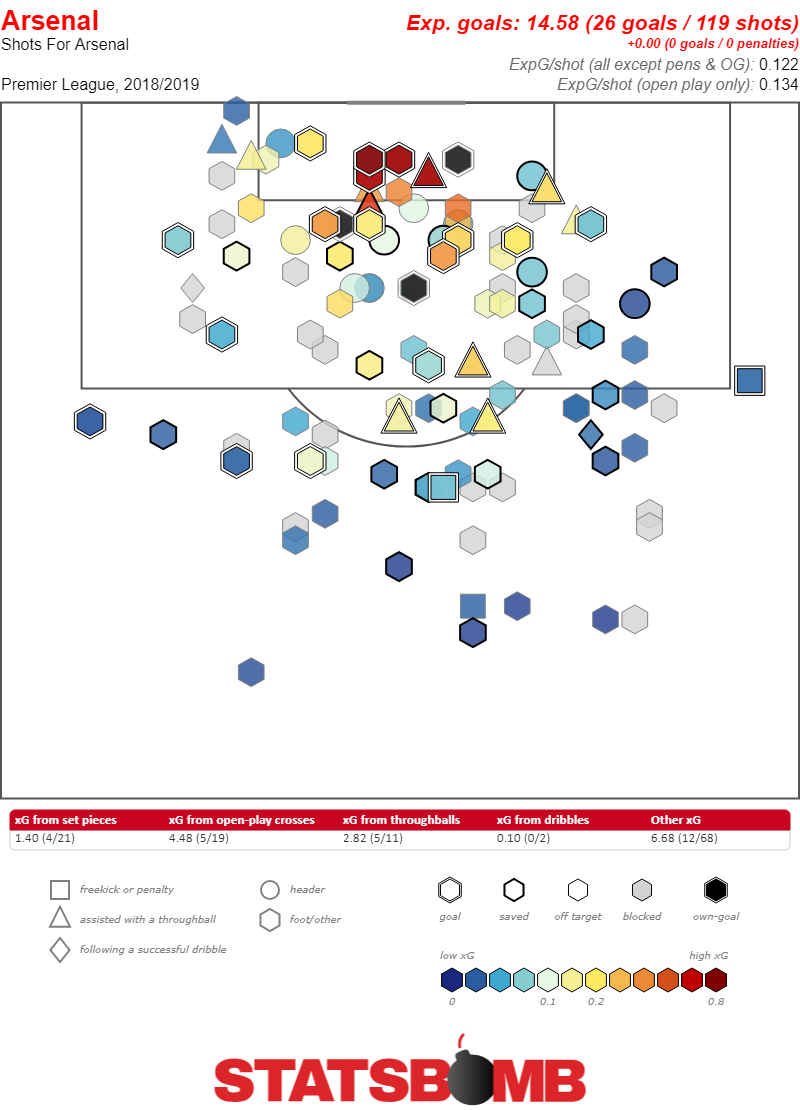 They’re obviously running hot, but they’re also producing a lot more. More shots, more xG, and a better xG per shot ratio. Everything improves. Drill down a little deeper and we can isolate some of the change. Specifically, the way Arsenal play when they’re drawing is vastly different half to half. Here’s the first half.
They’re obviously running hot, but they’re also producing a lot more. More shots, more xG, and a better xG per shot ratio. Everything improves. Drill down a little deeper and we can isolate some of the change. Specifically, the way Arsenal play when they’re drawing is vastly different half to half. Here’s the first half. 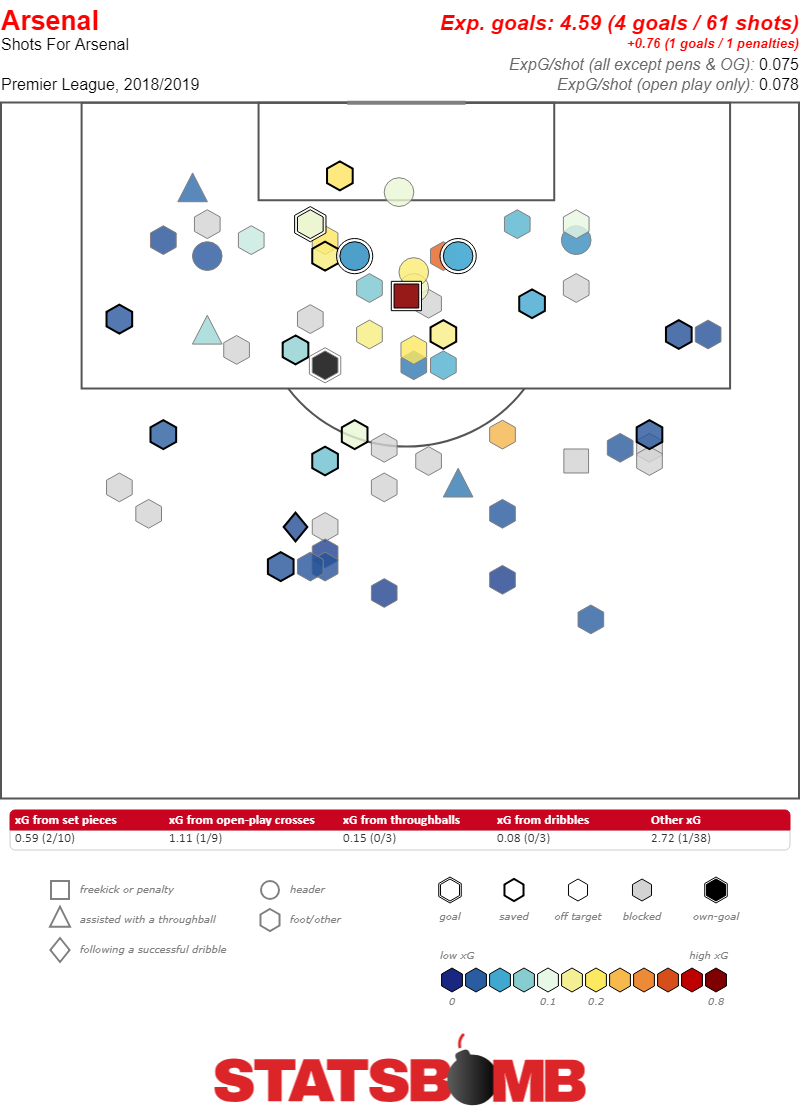 Again, not particularly inspiring. It’s fine, but 0.075 expected goals per shot is not the kind of attack on which successful teams are built, especially successful teams relying on their attack. The second half is better.
Again, not particularly inspiring. It’s fine, but 0.075 expected goals per shot is not the kind of attack on which successful teams are built, especially successful teams relying on their attack. The second half is better. 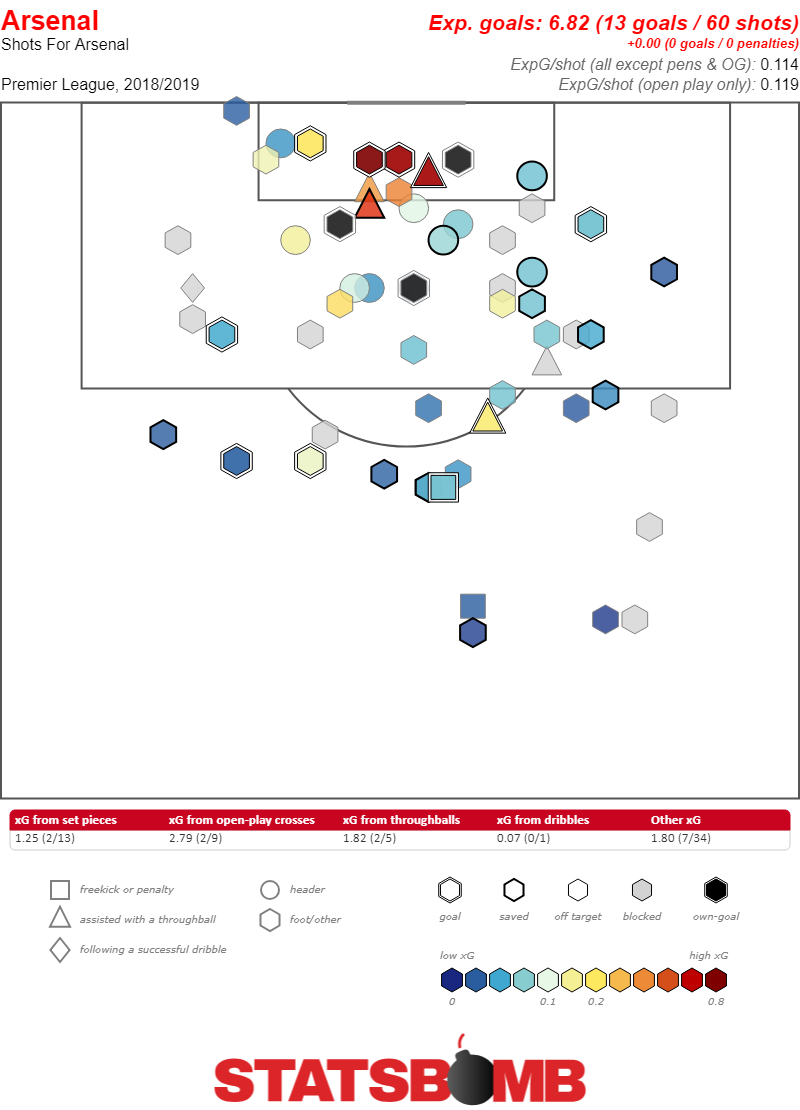 These numbers are obviously juiced by a ludicrous three own goals (and if you count the one in the first half, that makes four matches, or a full quarter of Arsenal’s games, where they’ve gone ahead through an own goal) but even so the jump from 0.075 xG per shot to 0.114 is no joke. So there’s something real going on there. But, at the same time that real tactical shift is also being exaggerated by a particular kind of bad luck. Here’s the shot map that Arsenal have faced when they’re leading in the first half.
These numbers are obviously juiced by a ludicrous three own goals (and if you count the one in the first half, that makes four matches, or a full quarter of Arsenal’s games, where they’ve gone ahead through an own goal) but even so the jump from 0.075 xG per shot to 0.114 is no joke. So there’s something real going on there. But, at the same time that real tactical shift is also being exaggerated by a particular kind of bad luck. Here’s the shot map that Arsenal have faced when they’re leading in the first half. 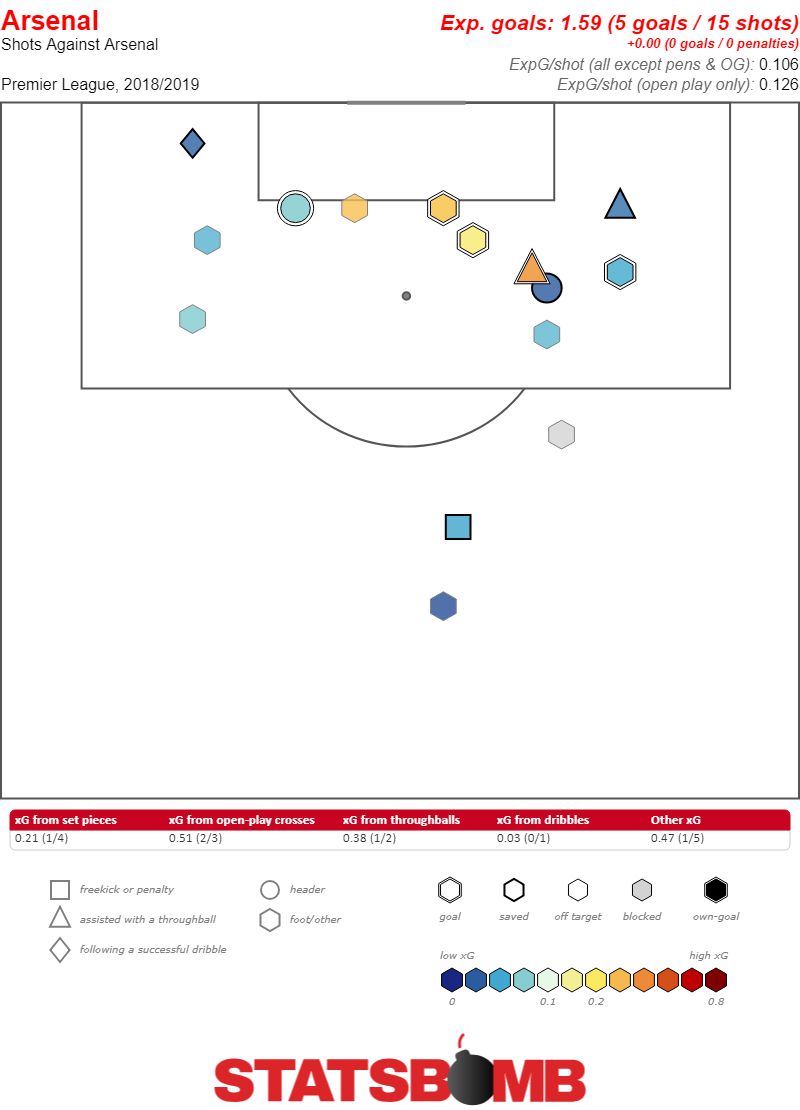 They’ve conceded five goals from a grand total of 15 shots! And not even particularly good shots. If they’d conceded the one or two you’d expect them to, well that’s a handful of games where they get to 45 minutes with a lead instead of getting pegged back. So, Arsenal really do approach the first half differently to the second half, although perhaps not so extremely differently as might be suggested by their weird record. The other thing to note in conjunction with the difference in halves is that Emery is, in fact, very aggressive when making substitutions. On average Arsenal make subs sooner than any other team in the Premier League.
They’ve conceded five goals from a grand total of 15 shots! And not even particularly good shots. If they’d conceded the one or two you’d expect them to, well that’s a handful of games where they get to 45 minutes with a lead instead of getting pegged back. So, Arsenal really do approach the first half differently to the second half, although perhaps not so extremely differently as might be suggested by their weird record. The other thing to note in conjunction with the difference in halves is that Emery is, in fact, very aggressive when making substitutions. On average Arsenal make subs sooner than any other team in the Premier League. 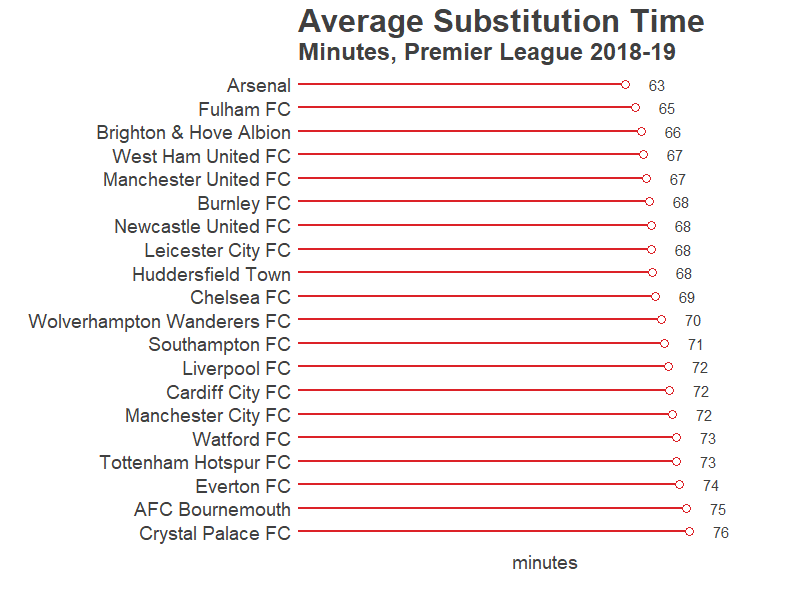 Disentangling cause and effect here is difficult. Would Emery’s substitutions be as dramatic is the team wasn’t running badly the times they do go ahead? It’s hard to say. Similarly, is Emery choosing the wrong lineups and then correcting them, or is he actively choosing an approach which gets substantially less conservative as the game goes on? That’s not unusual. Lots of managers, even managers of teams with substantial attacking talent, like to keep it tight for an hour before pouring it on late in the match. The numbers don’t solve the chicken and egg problem of whether Emery’s tactical changes are in reaction to Arsenal’s performance, or causing them, or some combination of both, but they do show that there’s a chicken and egg problem to solve. The difference between Arsenal in the first half and Arsenal in the second half is pretty vast. The reasons for that difference, like the reasons for most things, fall firmly in the gray area between total randomness and being completely within the team’s control. They’re playing differently, but they’re also getting unlucky in ways which are magnifying that difference. Throw a manager who is willing to aggressively react and use substitutions to change the makeup of the team into that stew and you’ve got Arsenal. They’re pretty good. They’re pretty weird. But if being pretty weird is the worst thing you can say about the Gunners, that’s a lot better than where they were a couple of months ago. Header image courtesy of the Press Association
Disentangling cause and effect here is difficult. Would Emery’s substitutions be as dramatic is the team wasn’t running badly the times they do go ahead? It’s hard to say. Similarly, is Emery choosing the wrong lineups and then correcting them, or is he actively choosing an approach which gets substantially less conservative as the game goes on? That’s not unusual. Lots of managers, even managers of teams with substantial attacking talent, like to keep it tight for an hour before pouring it on late in the match. The numbers don’t solve the chicken and egg problem of whether Emery’s tactical changes are in reaction to Arsenal’s performance, or causing them, or some combination of both, but they do show that there’s a chicken and egg problem to solve. The difference between Arsenal in the first half and Arsenal in the second half is pretty vast. The reasons for that difference, like the reasons for most things, fall firmly in the gray area between total randomness and being completely within the team’s control. They’re playing differently, but they’re also getting unlucky in ways which are magnifying that difference. Throw a manager who is willing to aggressively react and use substitutions to change the makeup of the team into that stew and you’ve got Arsenal. They’re pretty good. They’re pretty weird. But if being pretty weird is the worst thing you can say about the Gunners, that’s a lot better than where they were a couple of months ago. Header image courtesy of the Press Association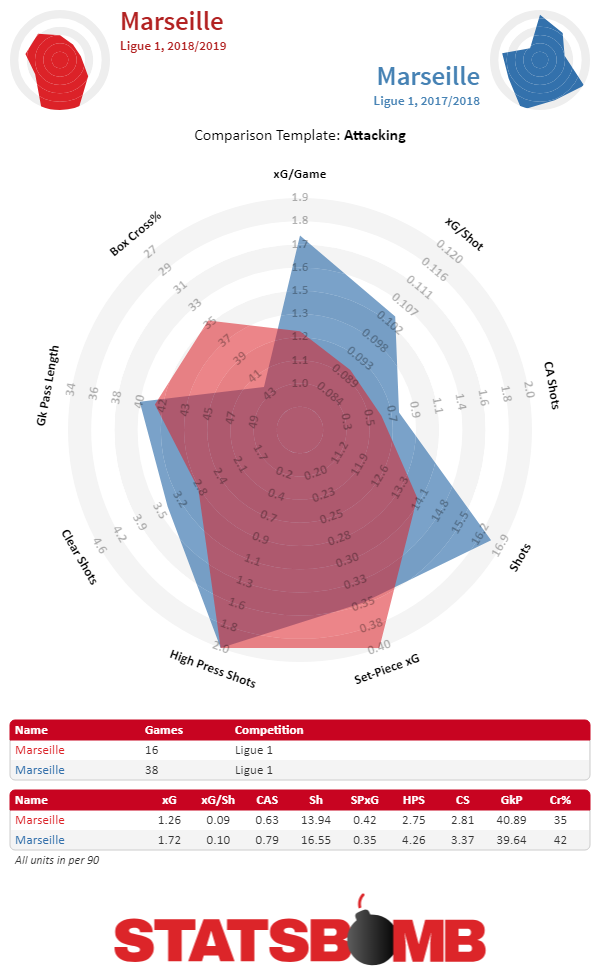
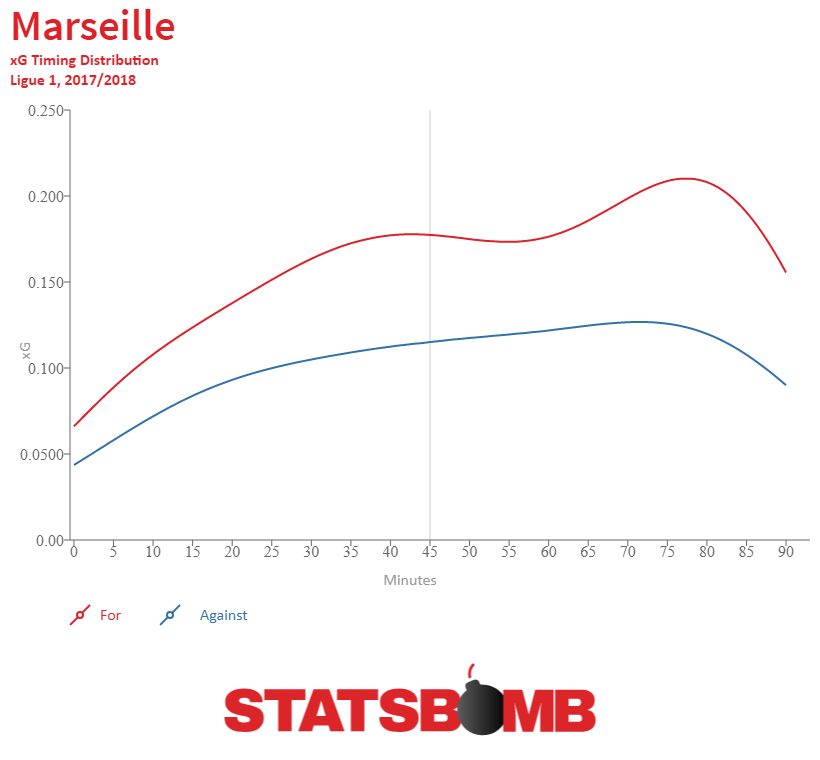
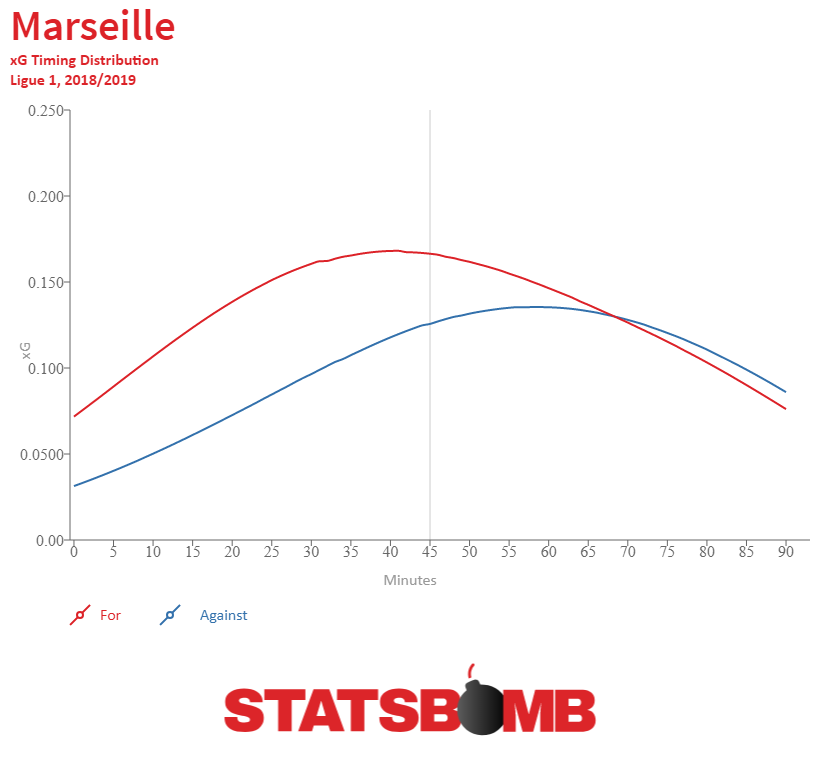
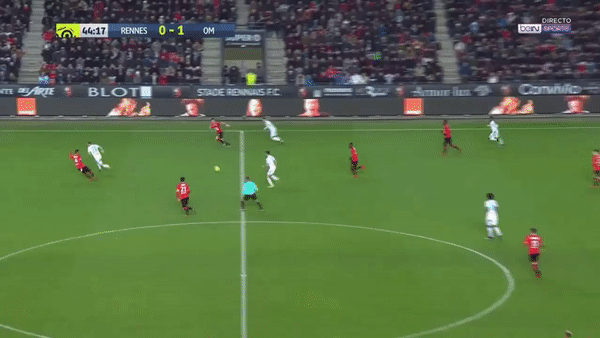
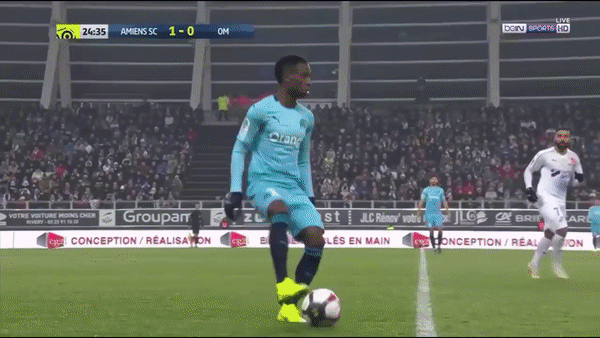 Marseille made a big bet over the summer by effectively switching Andre Zambo Anguissa for Kevin Strootman. It was one that fit their philosophy of getting an established veteran player with a little bit of name cache, especially given Strootman's experience under Garcia at Roma. Selling Zambo Anguissa at the price he went for, in isolation, was a defensible move. Even though I thought Zambo Anguissa was very good and played a larger role than people realized in Marseille's success, it's understandable that Marseille sold high on him. It was an undeniable risk to place as many eggs as Marseille did in the Strootman basket. As a club, you better be damn sure whenever you're spending ample resources (wages and transfer fee) on a player at that age bracket. Maybe things can turn around, but to this point, Strootman has not provided close to the same value that Zambo Anguissa brought to the table last season.
Marseille made a big bet over the summer by effectively switching Andre Zambo Anguissa for Kevin Strootman. It was one that fit their philosophy of getting an established veteran player with a little bit of name cache, especially given Strootman's experience under Garcia at Roma. Selling Zambo Anguissa at the price he went for, in isolation, was a defensible move. Even though I thought Zambo Anguissa was very good and played a larger role than people realized in Marseille's success, it's understandable that Marseille sold high on him. It was an undeniable risk to place as many eggs as Marseille did in the Strootman basket. As a club, you better be damn sure whenever you're spending ample resources (wages and transfer fee) on a player at that age bracket. Maybe things can turn around, but to this point, Strootman has not provided close to the same value that Zambo Anguissa brought to the table last season. 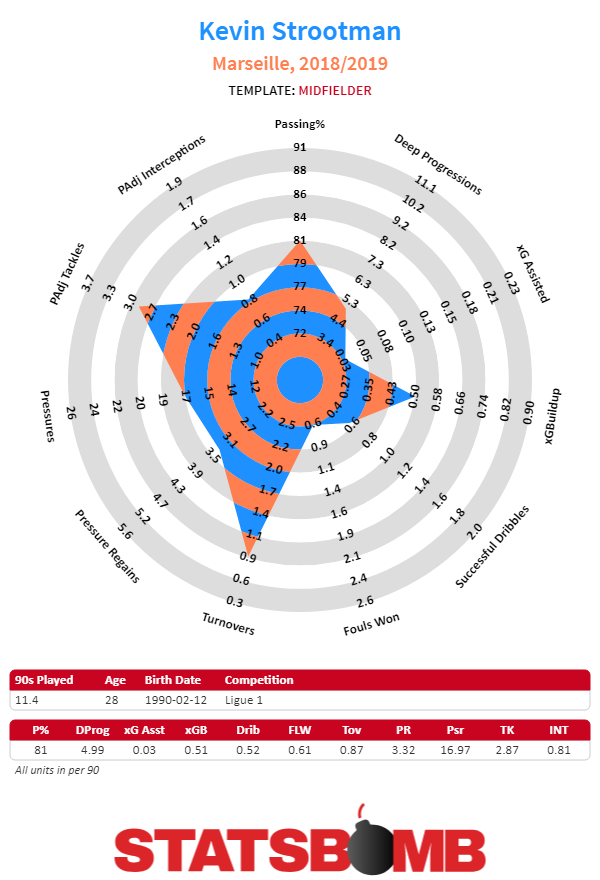 For the amount of money that Marseille have spent over the past few transfer windows, it's pretty odd that little of that cash has gone to replenishing the goalkeeper situation that's been in desperate need of improvement. For all the good things that Steve Mandanda has done during his time at Marseille, there's evidence to suggest that a replacement is needed. Both last season and in this season, Mandanda has been below average in Goal Saved Above Average % (difference between actual-expected save percentage). This season, Mandanda ranks 21st among all Ligue 1 keepers in GSAA% at -6.9%. Yohann Pele, Marseille's backup, ranks 27th with a GSAA% at -19.8%. Having multiple goalkeepers who are performing significantly below average in shot stopping is a recipe for leaking goals at a higher rate.
For the amount of money that Marseille have spent over the past few transfer windows, it's pretty odd that little of that cash has gone to replenishing the goalkeeper situation that's been in desperate need of improvement. For all the good things that Steve Mandanda has done during his time at Marseille, there's evidence to suggest that a replacement is needed. Both last season and in this season, Mandanda has been below average in Goal Saved Above Average % (difference between actual-expected save percentage). This season, Mandanda ranks 21st among all Ligue 1 keepers in GSAA% at -6.9%. Yohann Pele, Marseille's backup, ranks 27th with a GSAA% at -19.8%. Having multiple goalkeepers who are performing significantly below average in shot stopping is a recipe for leaking goals at a higher rate. 